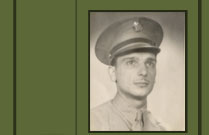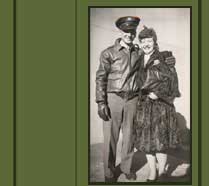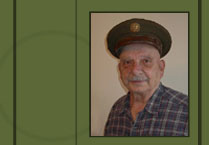1st Lt. Don Leigh
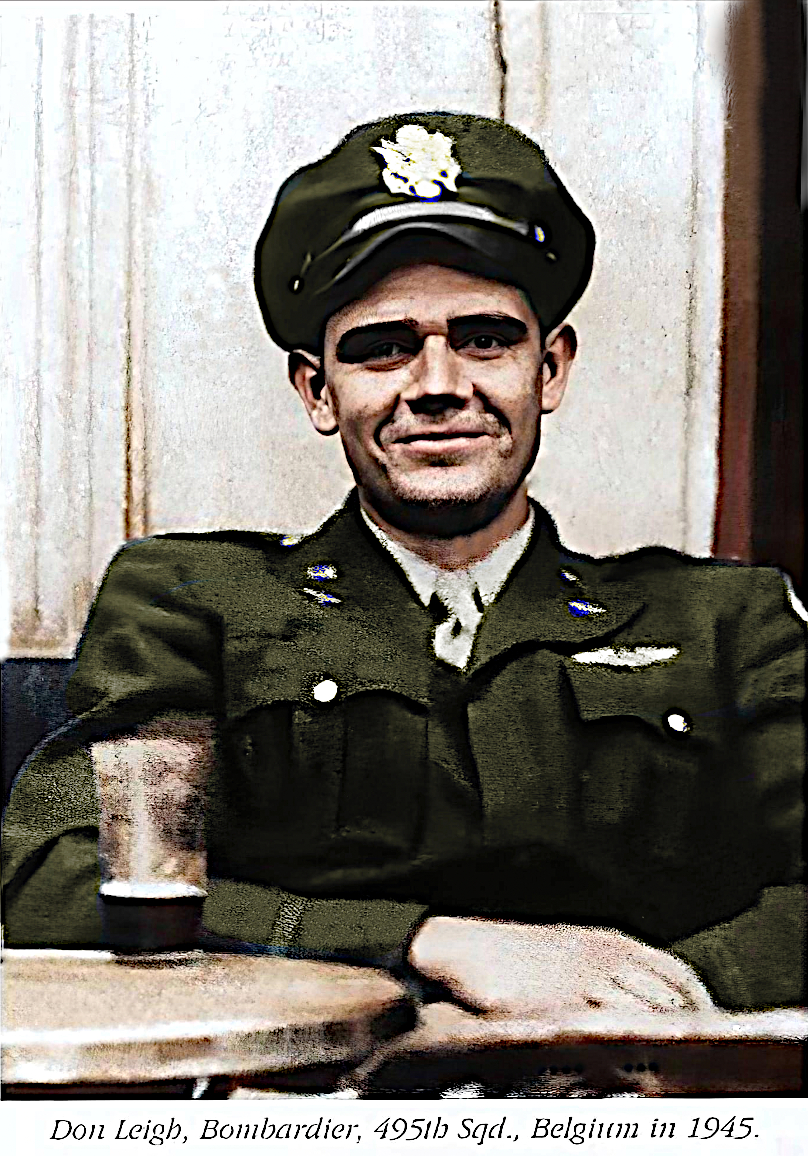
Lt. Donald Leigh was born on April 5, 1921 in Haverhill, MA, the son of Dorothy and Donald Leigh. He attended Middlebury College and the Northeastern College of Business in Boston. He served in World War II in the United States Air Corps as a Bombardier Navigator in the 344th Bombardment Group. He received several citations including the Distinguished Flying Cross and the Purple Heart. He passed away on Saturday, February 2, 2002.
Below is the complete list of Donald Leigh’s missions. Several of them will be documented here.

———————
Lt Leigh’s first mission with the 344th Bomb Group was August 16. they were sent to bomb an ammunition stack in the Foret de Roumaire. The mission was recalled before reaching the Foret and bombs were brought back. This was a good way for Leigh to get a taste of what was to come.

The formation diagram for August 16, 1944 to an ammuniton dump hidden in the Foret de Roumaire, France. 2nd Lt. Don Leigh’s first mission was flown flew in B-26 42-95919 Sexy Sal Y5-L piloted by Lt. Fitzsimmonds in position 2-1-2.
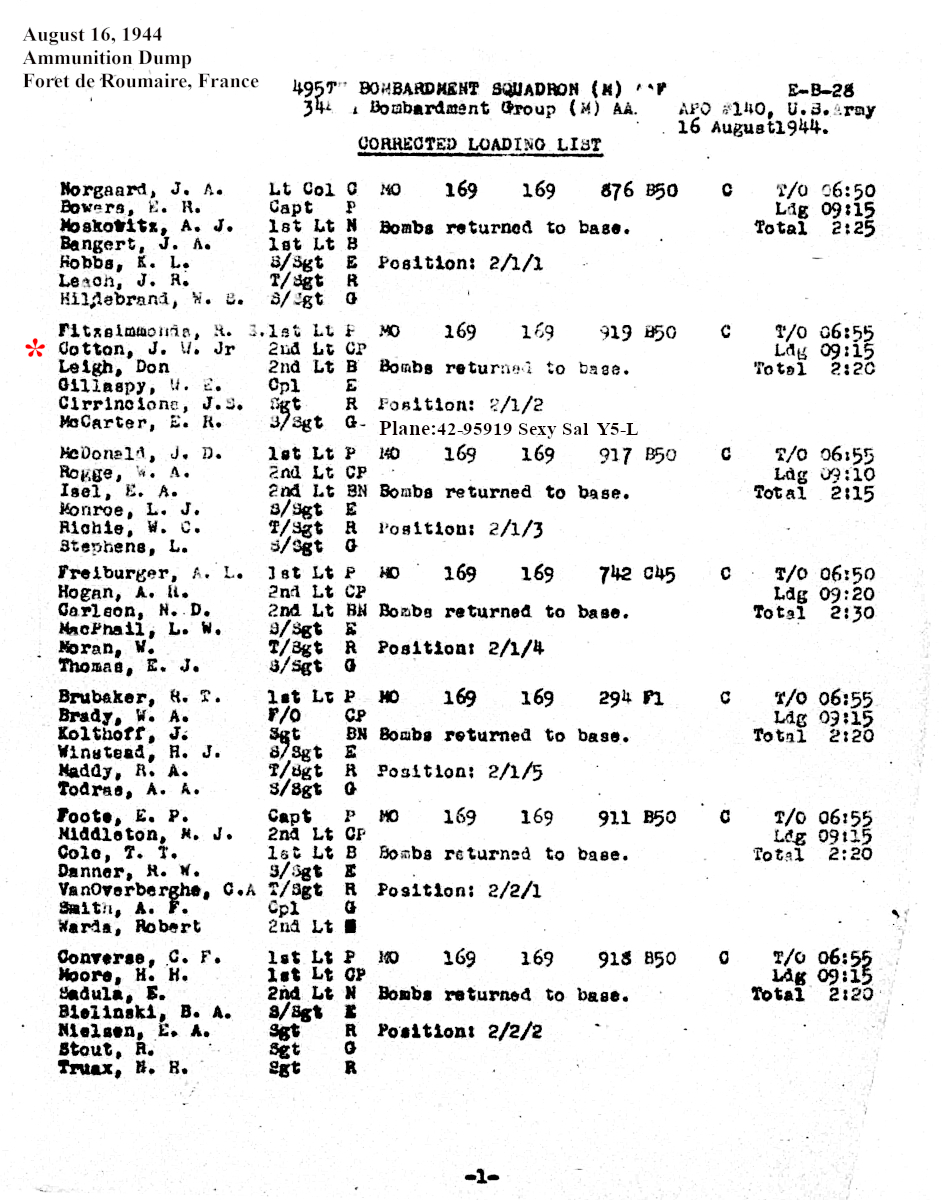
The mission of August 16, 1944 was assigned to destroy an ammunition dump hidden in the Foret de Roumaire. Because of weather the mission was recalled and the bombs were returned to base. Because it was the Leigh and Cotton’s first mission, they were led by the seasoned pilot, 1st Lt. Fitzsimmonds. The crew consisted of: 1st Lt. Fitzsimmonds, pilot; 2nd Lt. Cotton, co-pilot; 2nd Lt. Leigh bombardier; Sgt. Cirrincione, radio/gun; Cpl. Gillaspy, eng/gunner; S/Sgt. McCarter, gunner. They took off at 6:55 am in 42-95919 Sexy Sal Y5-L in formation position 2-1-2 and landed at 9:15 pm.
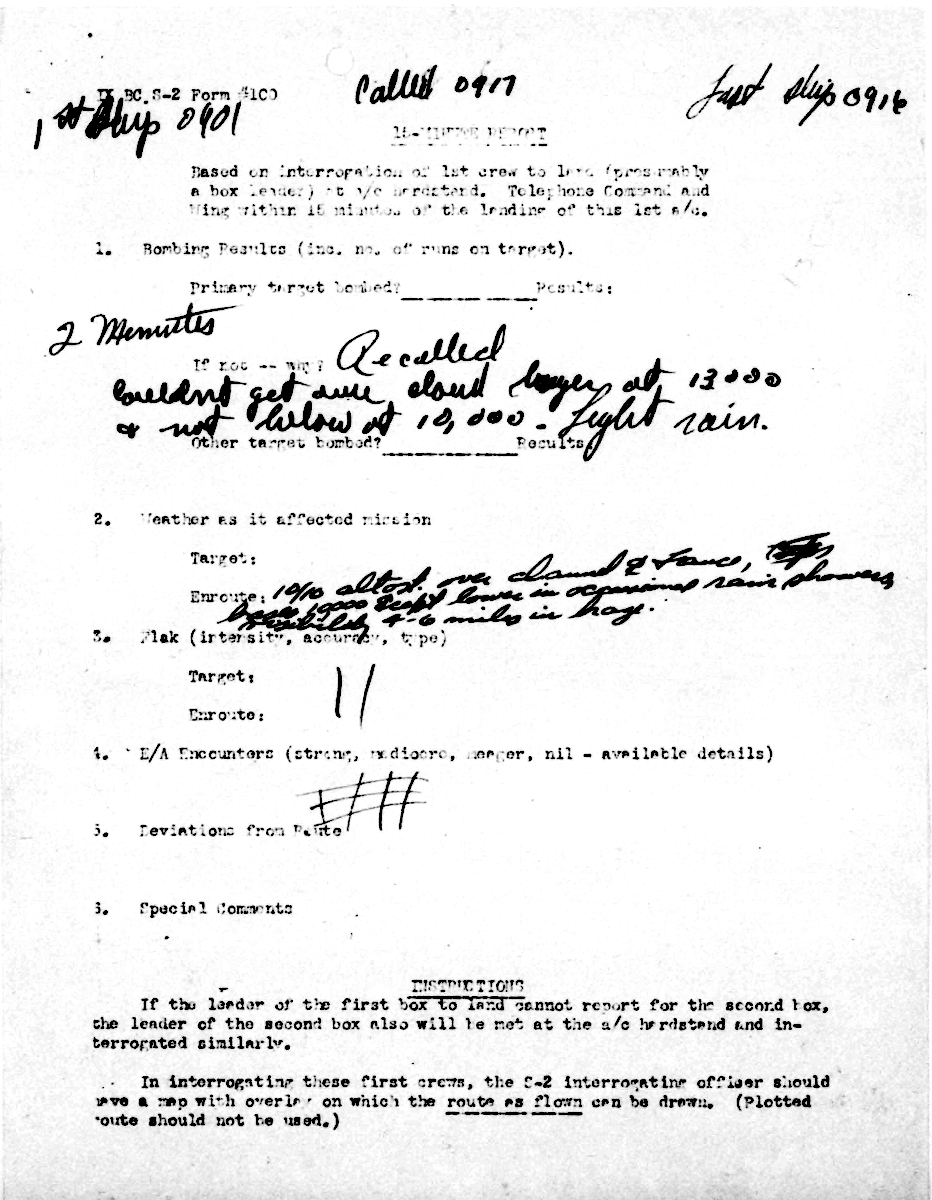
Mission of Aug. 16, 1944 recalled at 9:17 am. “Couldn’t get over cloud layer at 13,000 and not below at 10,000 – light rain.” “10/10 over channel and France, — 10,000 — lower in occasional rain showers visibility 4-6 miles in haze.”
—————————
(Leigh’s mission 5)- Sept. 3, 1944 Gun Positions Brest
According to 344th Silver Streaks– In the month of September, weather held operations
down to 14 days. In that period six missions were flown into the Brest area on 1, 3, 5, 6 and 14 of September to attack gun positions and defended areas, with gratifying results in support of our ground forces.
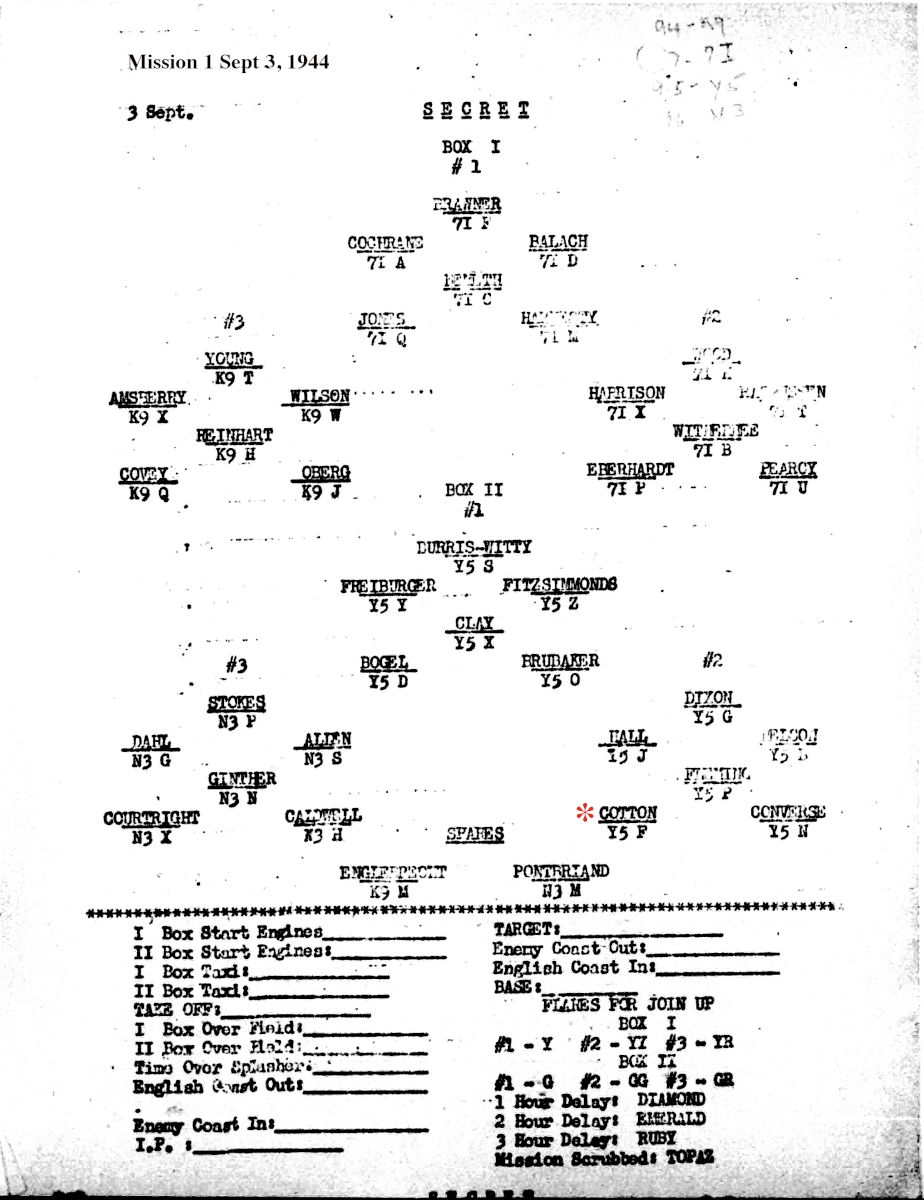
September 3, 1944 the first of two missions that day, found Don Leigh flying with pilot Cotton to Brest, France to attack gun positions. They flew in position 2-2-6. This is the first mission I was able to find for this crew.
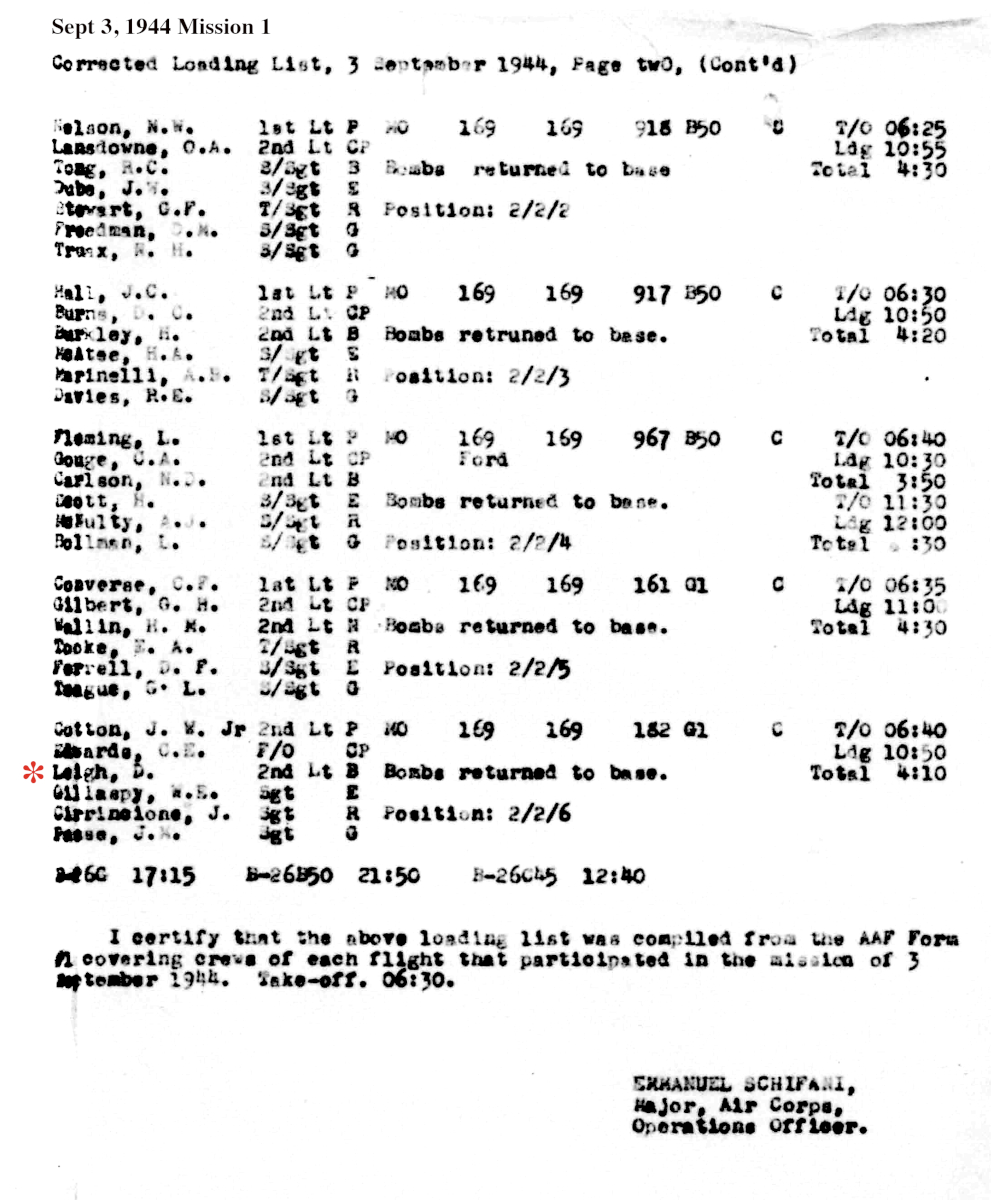
The first mission intended for Sept. 3, 1944 to a gun emplacement in Brest, France. The 495th squadron returned bombs to the base. Leigh did also fly the second mission of the day to the same location. The crew consisted of: 2nd Lt. Cotton, pilot; Flight Officer Edwards, co-pilot; 2nd Lt. Leigh bombardier; S/Sgt. Cirrincione, radio/gun; Sgt. Gillaspy, eng/gunner; Sgt. Passe. They took off at 6:40 am in plane 43-34182 Y5-F in formation position 2-2-6 and landed at 10:50 am.
(Leigh’s mission 6)- Sept. 3, 1944 Gun Positions Brest

September 3, 1944 the second mission of the day again found Don Leigh flying with pilot Cotton to Brest, France to attack gun positions. They flew in position 1-2-6 in plane 43-34182 Y5-F
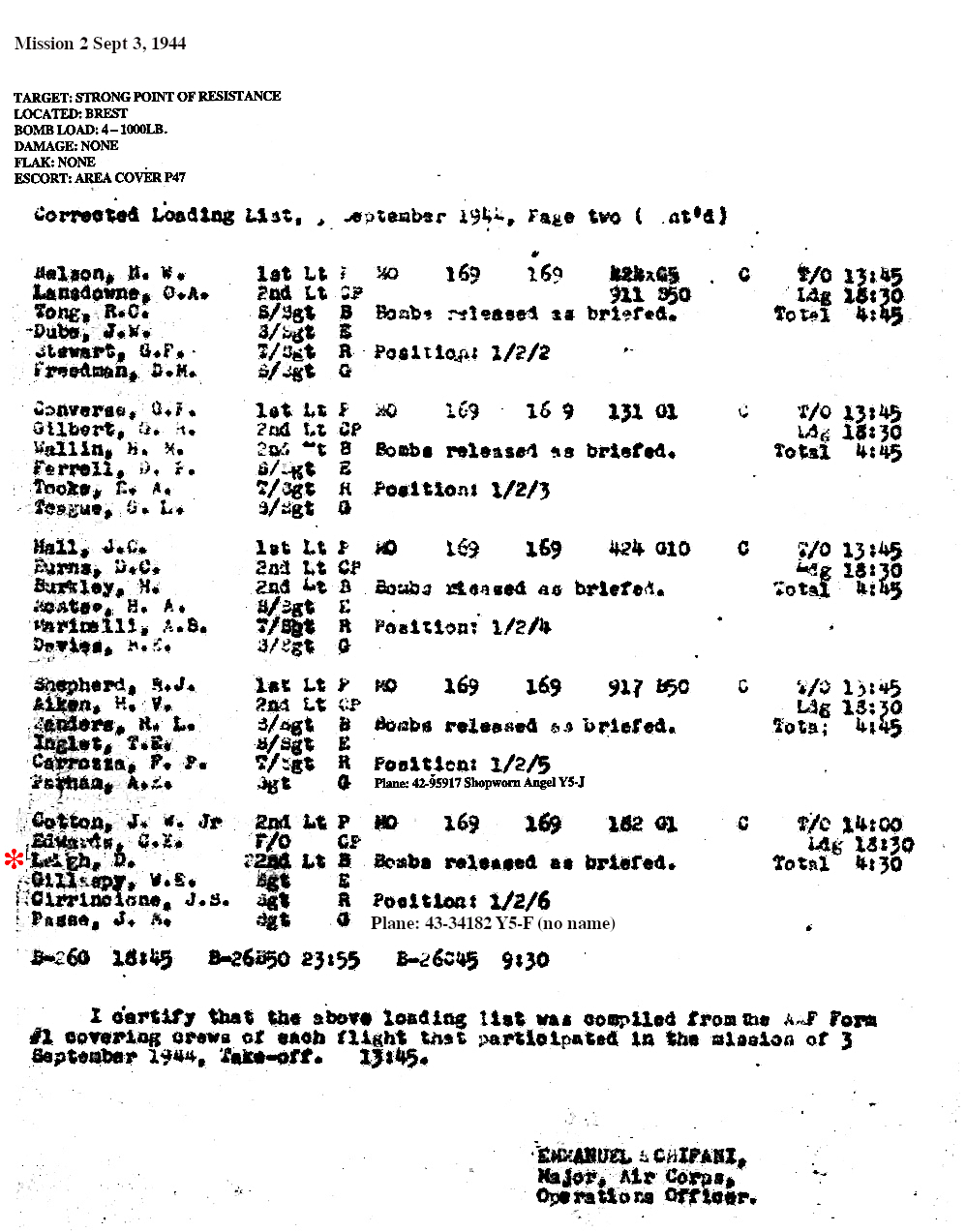
The second mission for Sept. 3, 1944 again targeted a gun emplacement in Brest, France. The 495th squadron released their bombs on target as briefed. The crew consisted of: 2nd Lt. Cotton, pilot; Flight Officer Edwards, co-pilot; 2nd Lt. Leigh bombardier; S/Sgt. Cirrincione, radio/gun; Sgt. Gillaspy, eng/gunner; Sgt. Passe gunner. They took off at 2:00 pm in plane 43-34182 Y5-F in formation position 1-2-6 and landed at 6:30 pm.
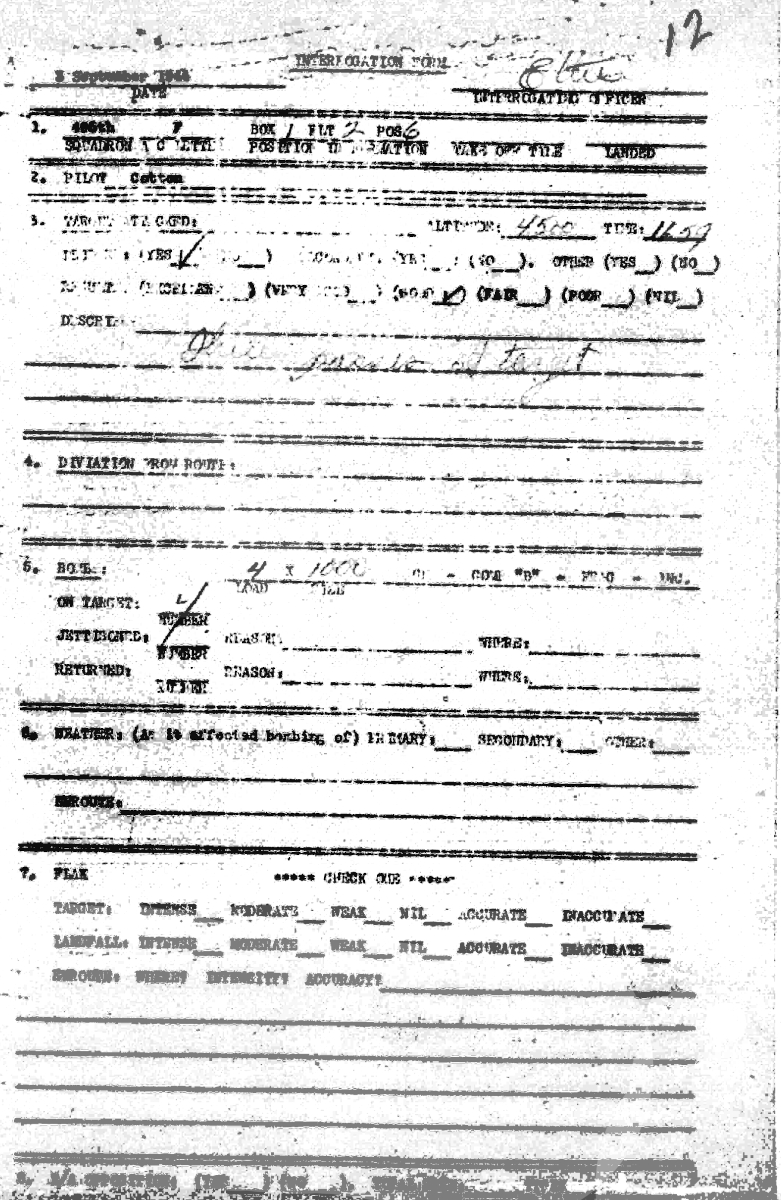
According to the mission debrief form complete by Pilot, Cotton, 2nd Lt. Leigh flew in, Y5-F, in formation position 1-2-6. The target was attacked from 4,500 feet at 2:59 pm using a load of 4 x 1000lb bombs. They hit their primary target with good results. No flak was indicated.
(Leigh’s mission 15) Oct. 7, 1944 Highway Bridge Nedder Riju River Bridge, Arnheim
According to 344th Silver Streaks– The Arnheim bridge was an important objective in the path of British and Canadian units fighting to hold the bridgehead they had established in the face of still opposition. The enemy had been rushing reinforcements and supplies over this structure bridging the Nedder Riju River a tributary of and continuation of the Rhine, and were making a formidable showing. Its destruction was accordingly imperative. Our efforts against it had not stopped the flow of traffic and we returned to this target October 7, this time making a good attack.
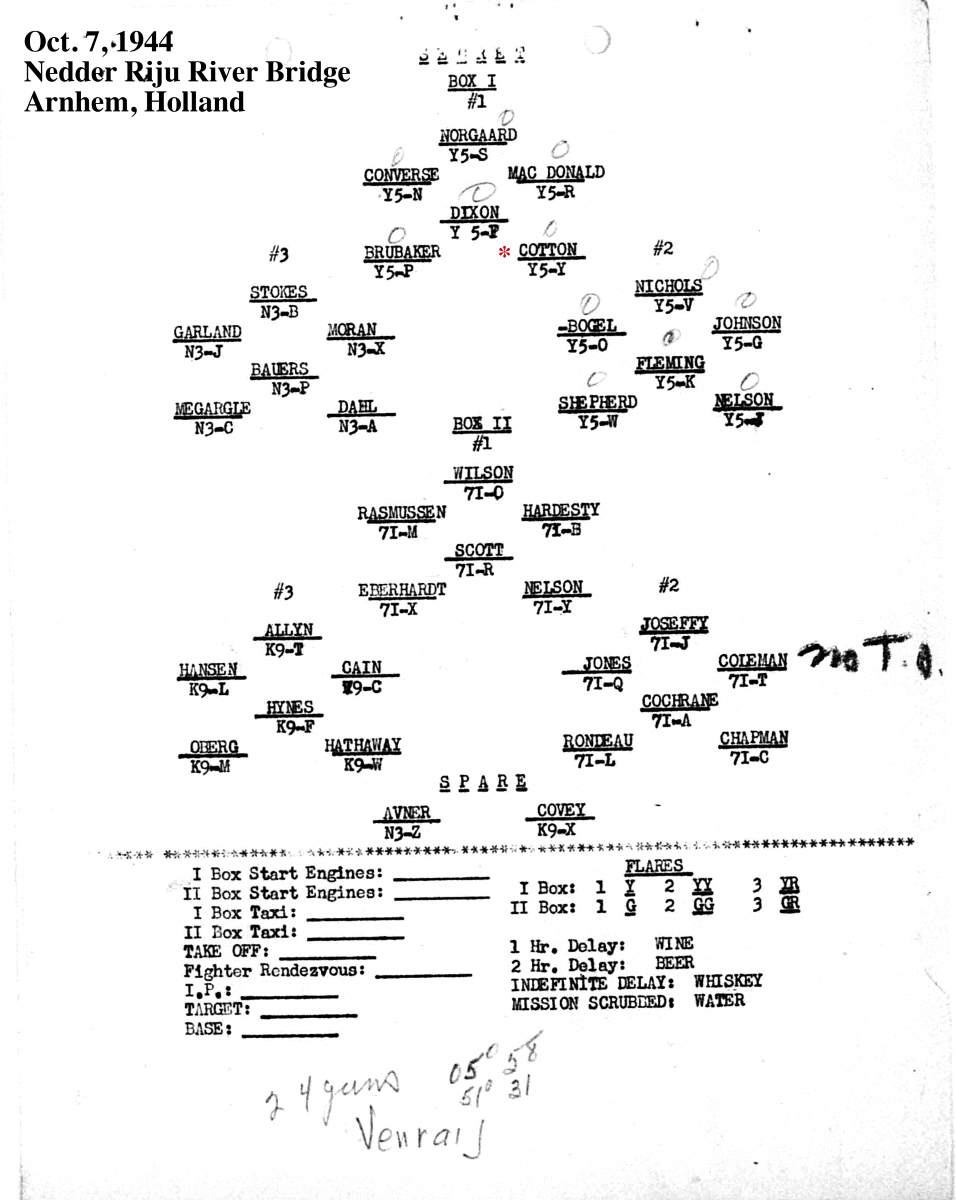
Don Leigh flew in, 43-34426 Y5-Y which was piloted by Cotton in position 1-1-5.
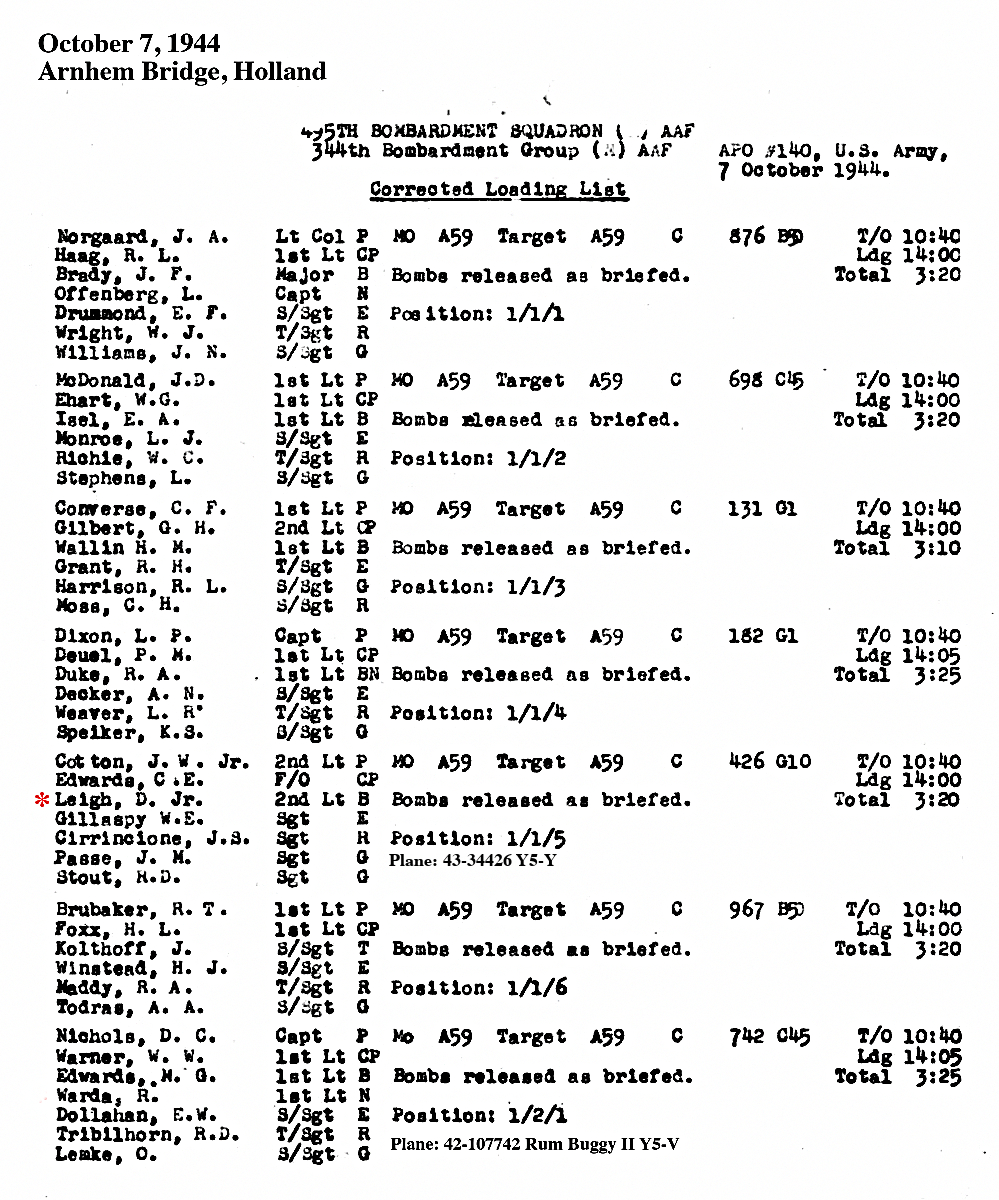
The crew consisted of: 2nd Lt. Cotton, pilot; Flight Officer Edwards, co-pilot; 2nd Lt. Leigh bombardier; S/Sgt. Cirrincione, radio/gun; Sgt. Gillaspy, eng/gunner; Sgt. Passe, gunner; Sgt. Stout, gunner. They flew in, 43-34426 Y5-Y, taking off at 10:40 am and landing at 2:00 pm. Their bombs were released on target as briefed.
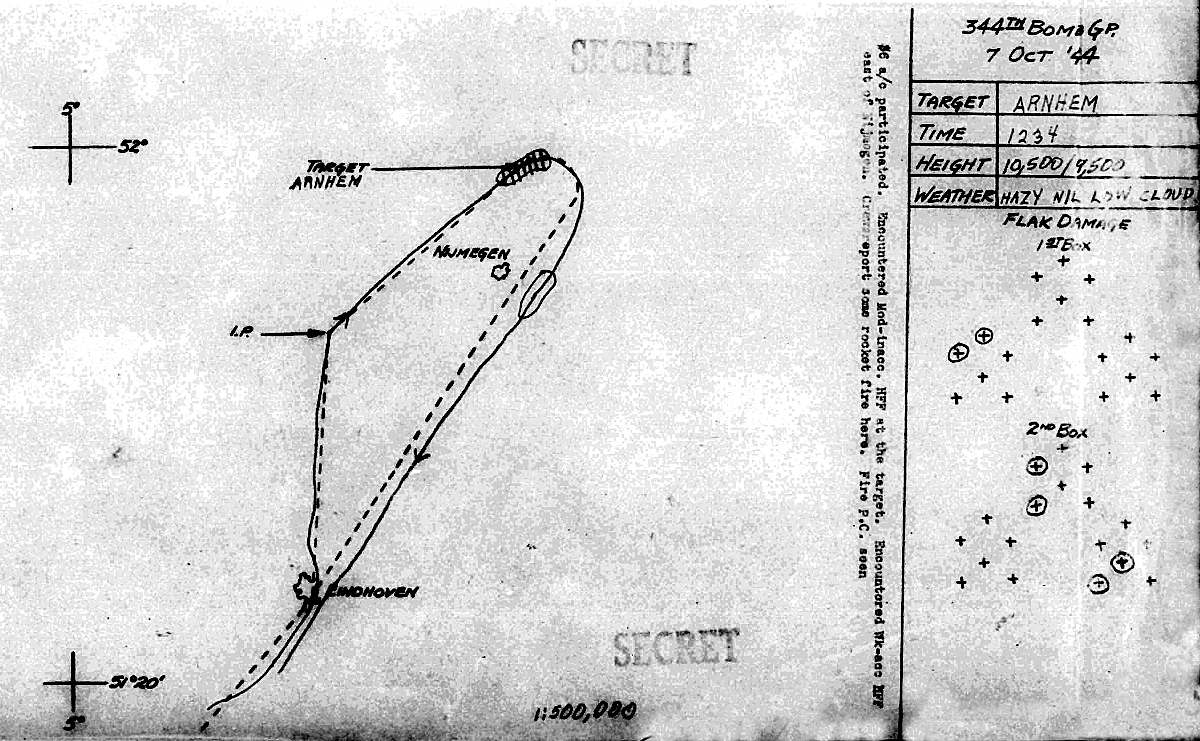
Catagory A damage to planes; 1-3-1, 1-3-3, 2-1-3, 2-1-6, 2-2-4, 2-2-6

(Leigh’s mission 22) Nov. 26, 1944 Ordnance Depot Sinzig-Geissen
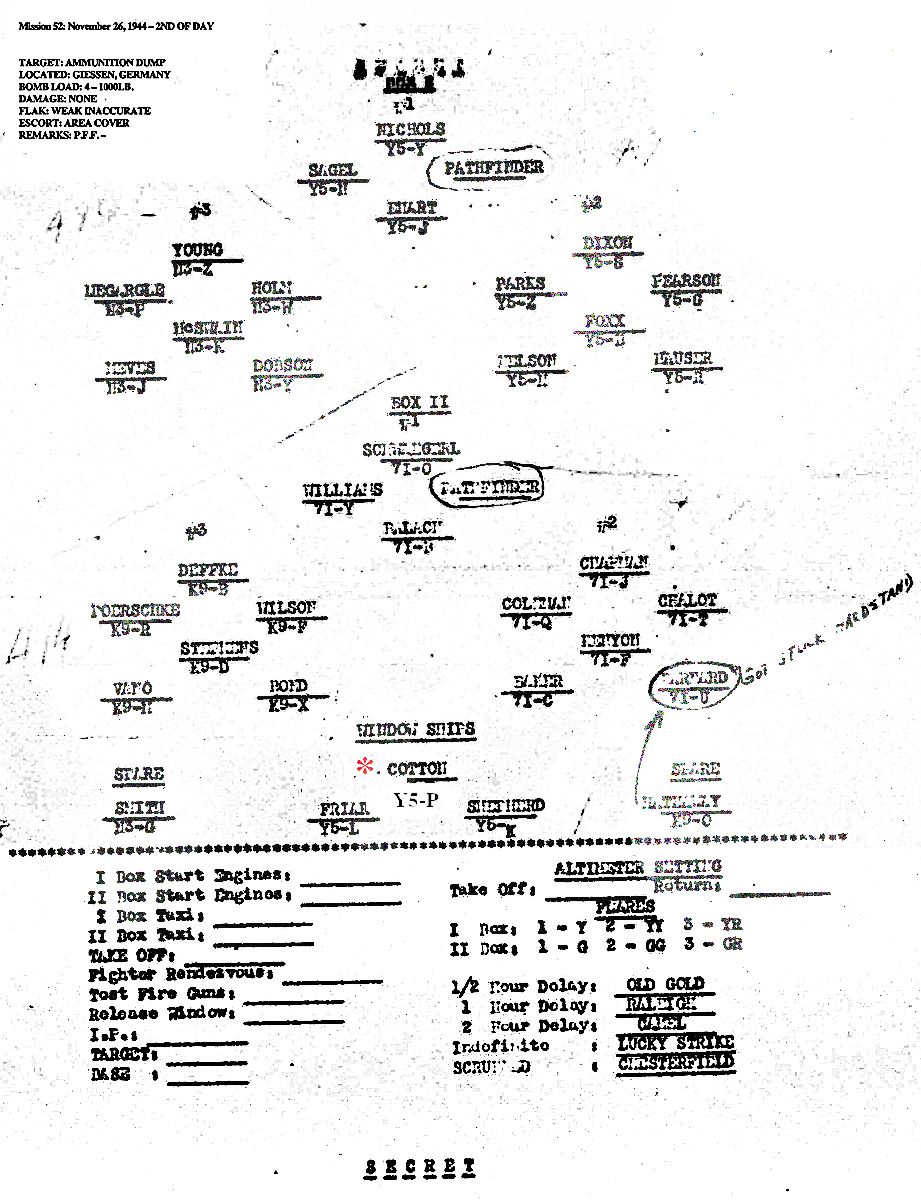
Don Leigh flew in, 42-95967 Rosie O’Brady Y5-P which was piloted by Cotton and served as one of the three “window” ships leading the formation. Flying “window” is a radar countermeasure in which aircraft spread a cloud of small, thin pieces of tinsel which either appears as a cluster of primary targets on radar screens or swamps the screen with multiple blips, in order to confuse and distract the radar of anti-aircraft gunners.
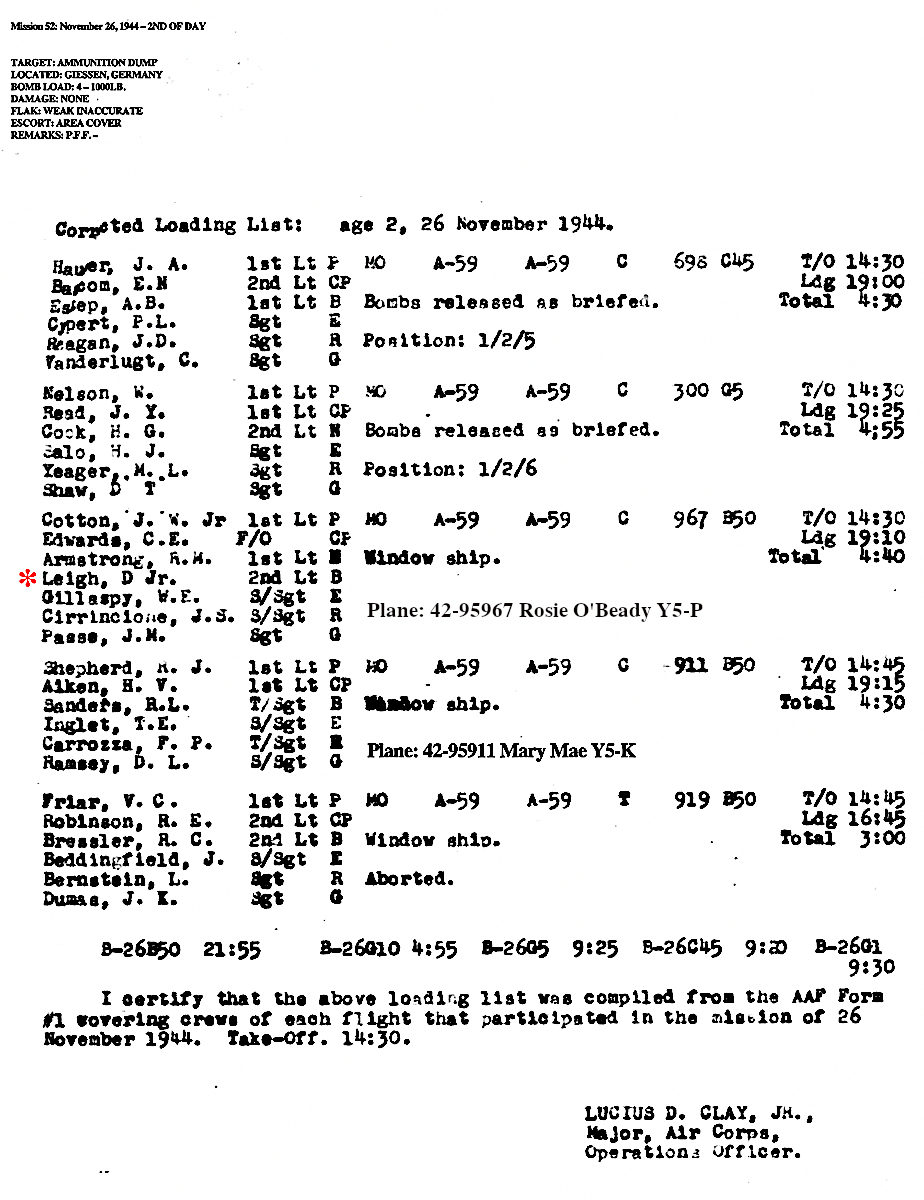
The crew consisted of: 2nd Lt. Cotton, pilot; Flight Officer Edwards, co-pilot; 2nd Lt. Leigh bombardier; 1st Lt. Armstrong, navigator; S/Sgt. Cirrincione, radio/gun; Sgt. Gillaspy, eng/gunner; Sgt. Passe, gunner; Sgt. Stout, gunner. They flew in, 42-95967 Rosie O’Brady Y5-P, taking off at 10:40 am and landing at 2:00 pm. They served as a “window” ship.
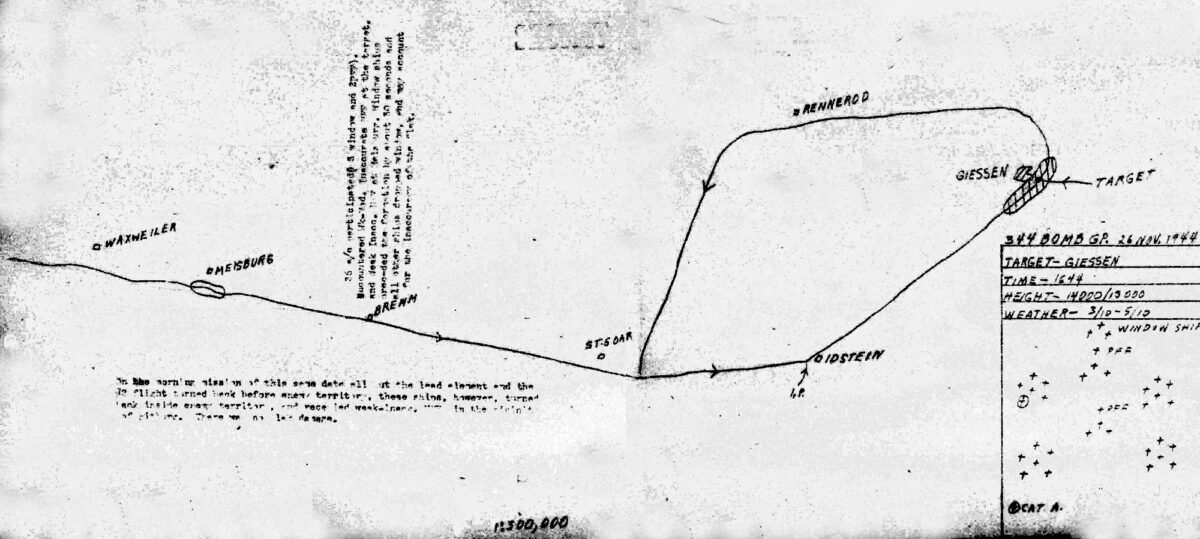
Hand drawn map for November 6, 1944 Target Geissen- “36 aircraft participated 3 window and 2 pff (Pathfinder). Encountered Wk-Mod inaccurate flak at the target and weak inaccurate flak at Meisburg. Window ships preceded the formation by about 30 seconds and all other ships dropped window and may account for the inaccuracy of the flak.”
Catagory A damage to plane 1-3-6.
Time of attack- 4:44 pm
Altitude- 14,000 / 13,000
Weather- 3-5/10
“On the morning mission of this same date, all of the lead element and the second flight turned back before enemy territory. These ships, however, turned back inside enemy territory and received weak, inaccurate flak in the vicinity of ? where we – – -.”
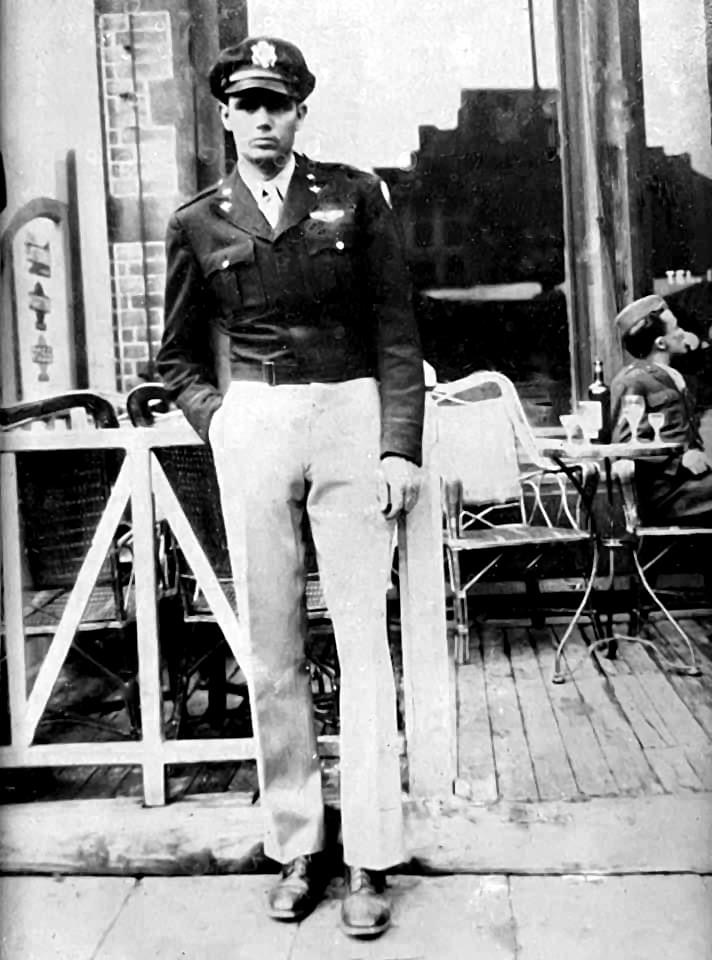
Lt. Donald Leigh on furlough. Paris perhaps?
(Leigh’s mission 26)The Dec. 10, 1944 mission was to a defended area at Birksop – Duren.
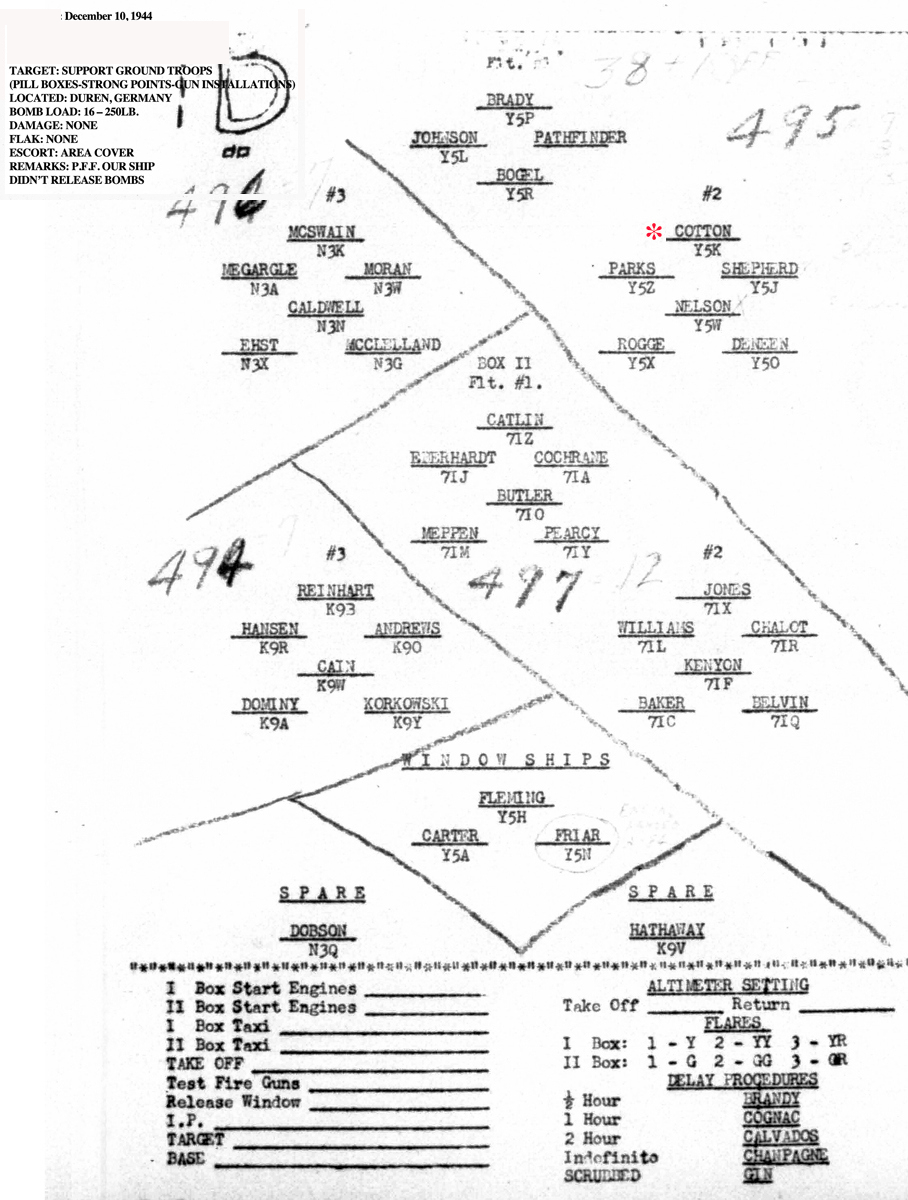
Don Leigh flew in, 42-95911 Mary Mae Y5-K which was piloted by Cotton in position 1-2-1. They earned the privilege of leading their flight.

The crew consisted of: 2nd Lt. Cotton, pilot; Flight Officer Edwards, co-pilot; 2nd Lt. Leigh bombardier; S/Sgt. Cirrincione, radio/gun; Sgt. Gillaspy, eng/gunner; S/Sgt. Tough, gunner. They flew in, 42-95911 Mary Mae Y5-K, taking off at 10:40 am and landing at 2:10 pm.
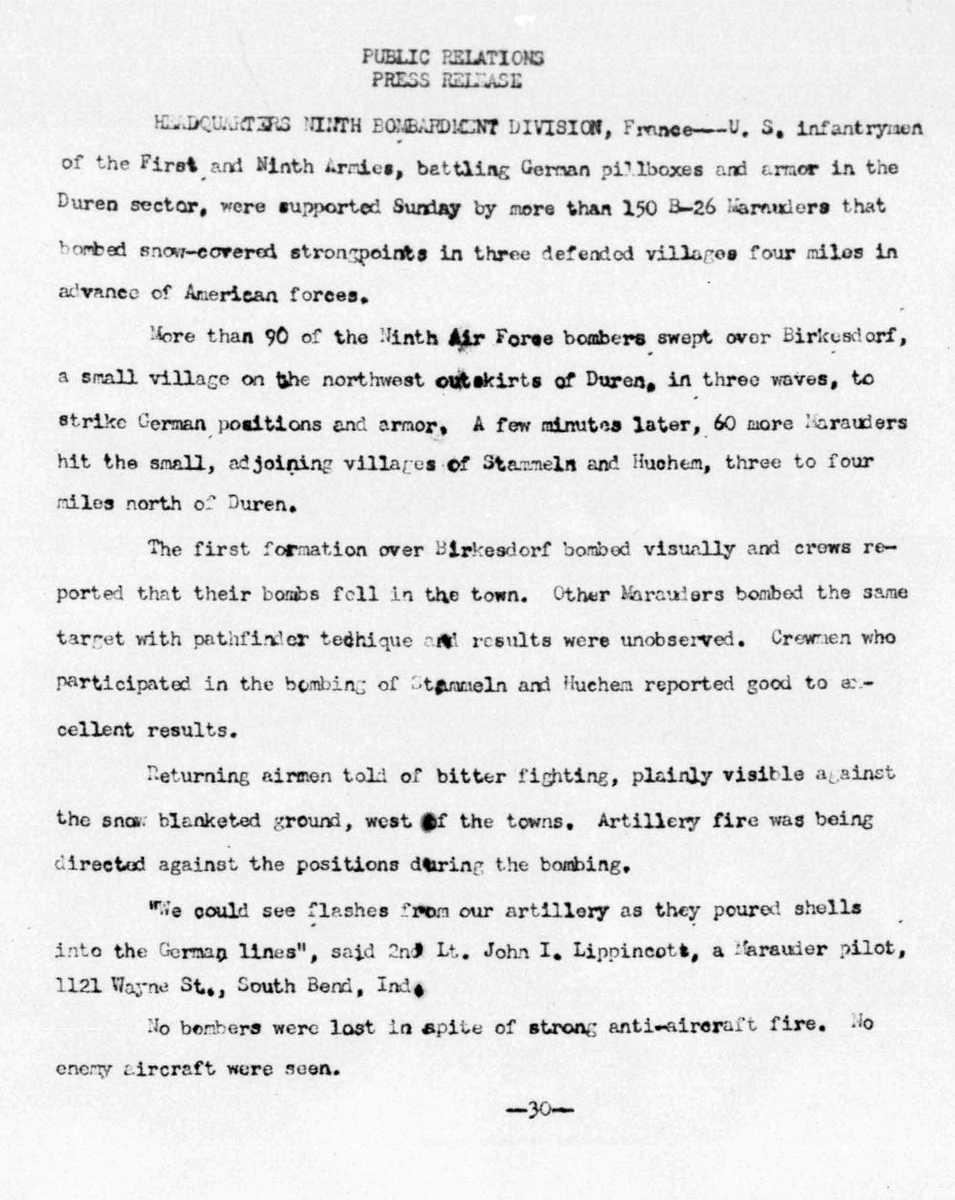
Press release describing the results of the Dec 10 mission.
According to 344th Silver Streaks– “We again bombed the Houffalize road junction January 11, after the enemy had hastily made his repairs, using 25 aircraft for the purpose, but the results were unobserved due to the haze and cloud cover in the area.”
This mission was part of the action known as the Battle of the Bulge (Ardennes). Note that Cotton and Leigh served as the leader of their flight.
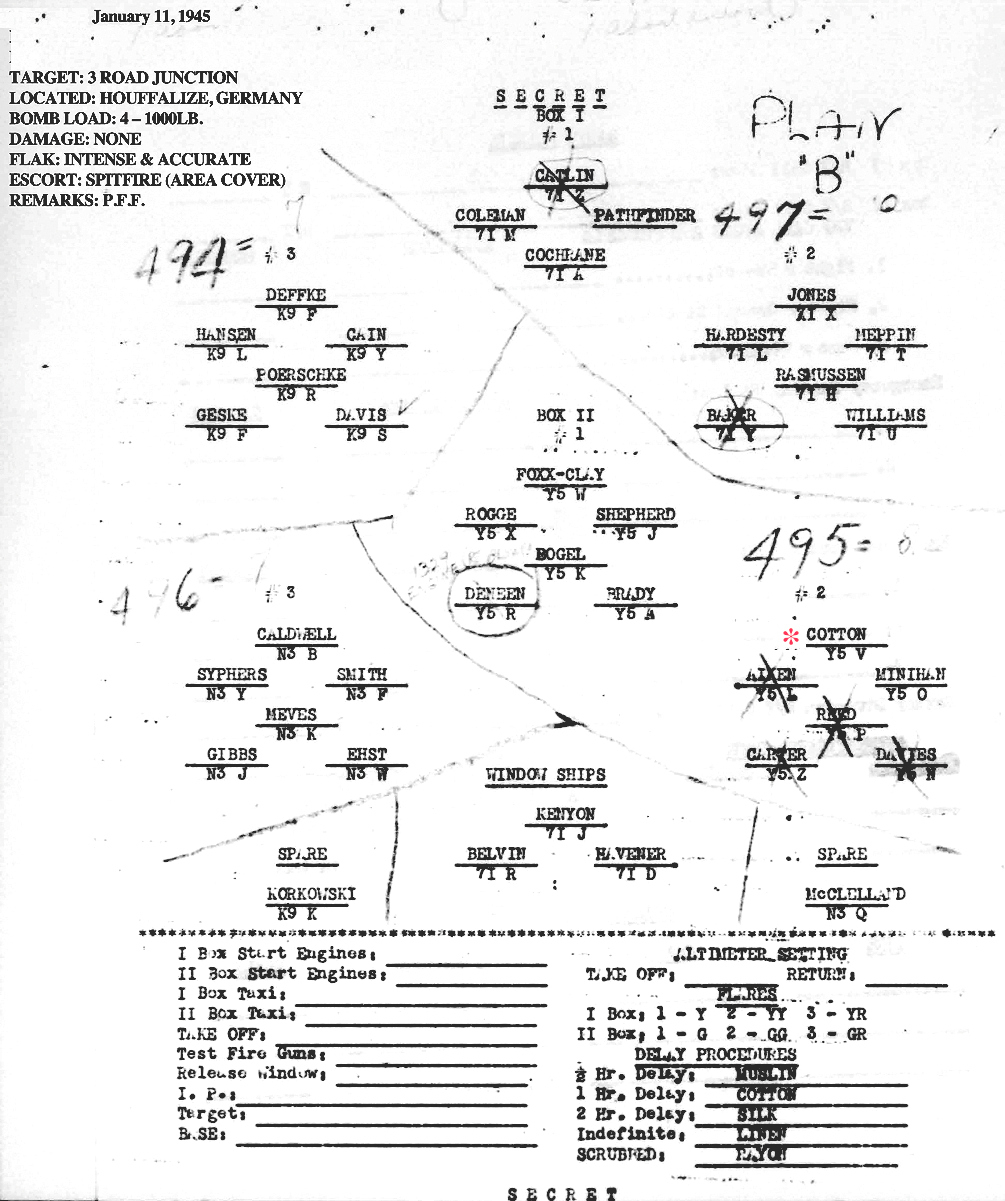
Don Leigh flew in, 43-34368 Y5-V which was piloted by Cotton in position 2-2-1.
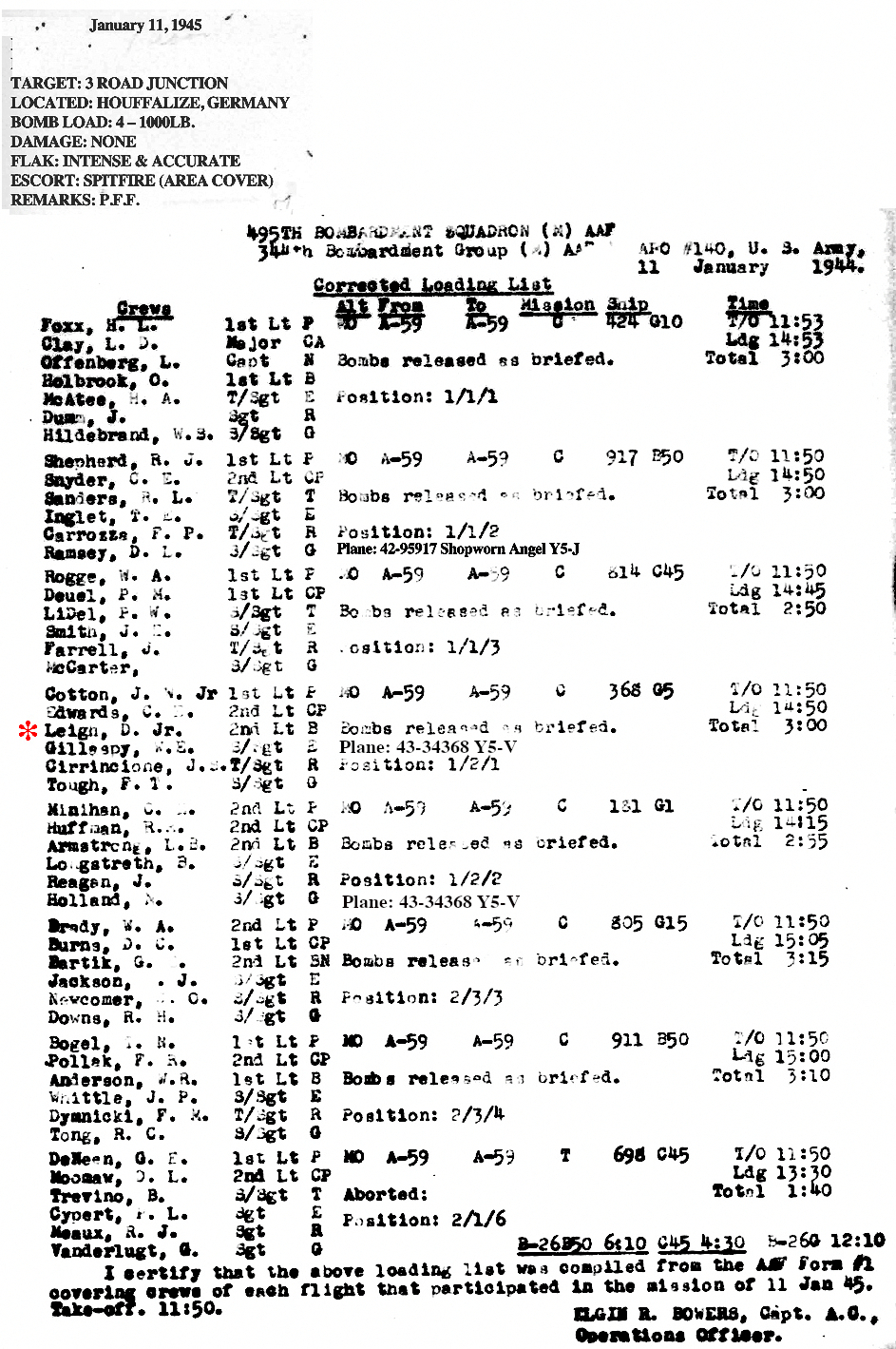
The crew consisted of: 1st Lt. Cotton, pilot; Flight Officer Edwards, co-pilot; 2nd Lt. Leigh bombardier; S/Sgt. Cirrincione, radio/gun; Sgt. Gillaspy, eng/gunner; S/Sgt. Tough, gunner. They flew in, 43-34368 Y5-V, taking off at 11:50 am and landing at 2:50 pm.
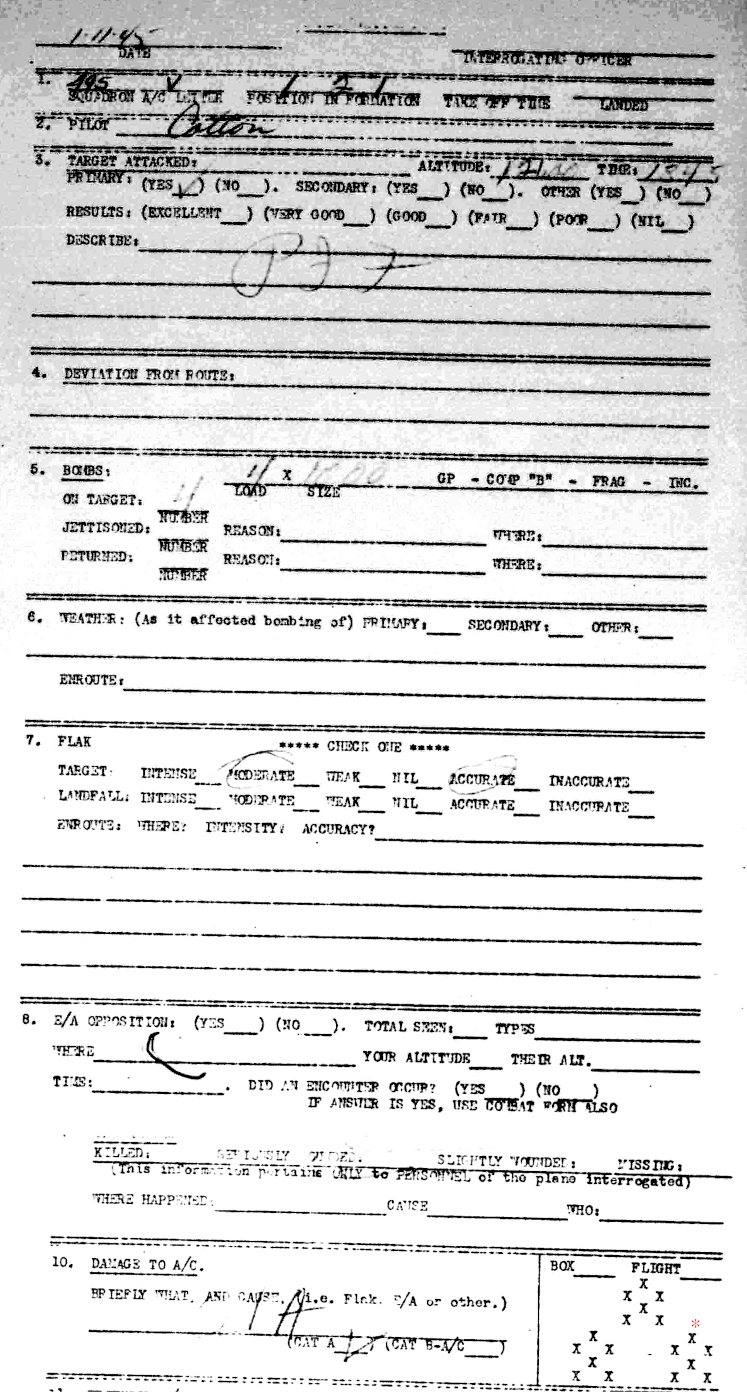
According to the mission debrief form complete by Pilot, Cotton, 2nd Lt. Leigh flew in, Y5-V, in formation position 1-2-1. The target was attacked from 12,600 feet at 1:45 pm using a load of 4 x 1000lb bombs. He did not indicate the results. They experienced moderate and accurate flak and received Cat. A damage to the aircraft.
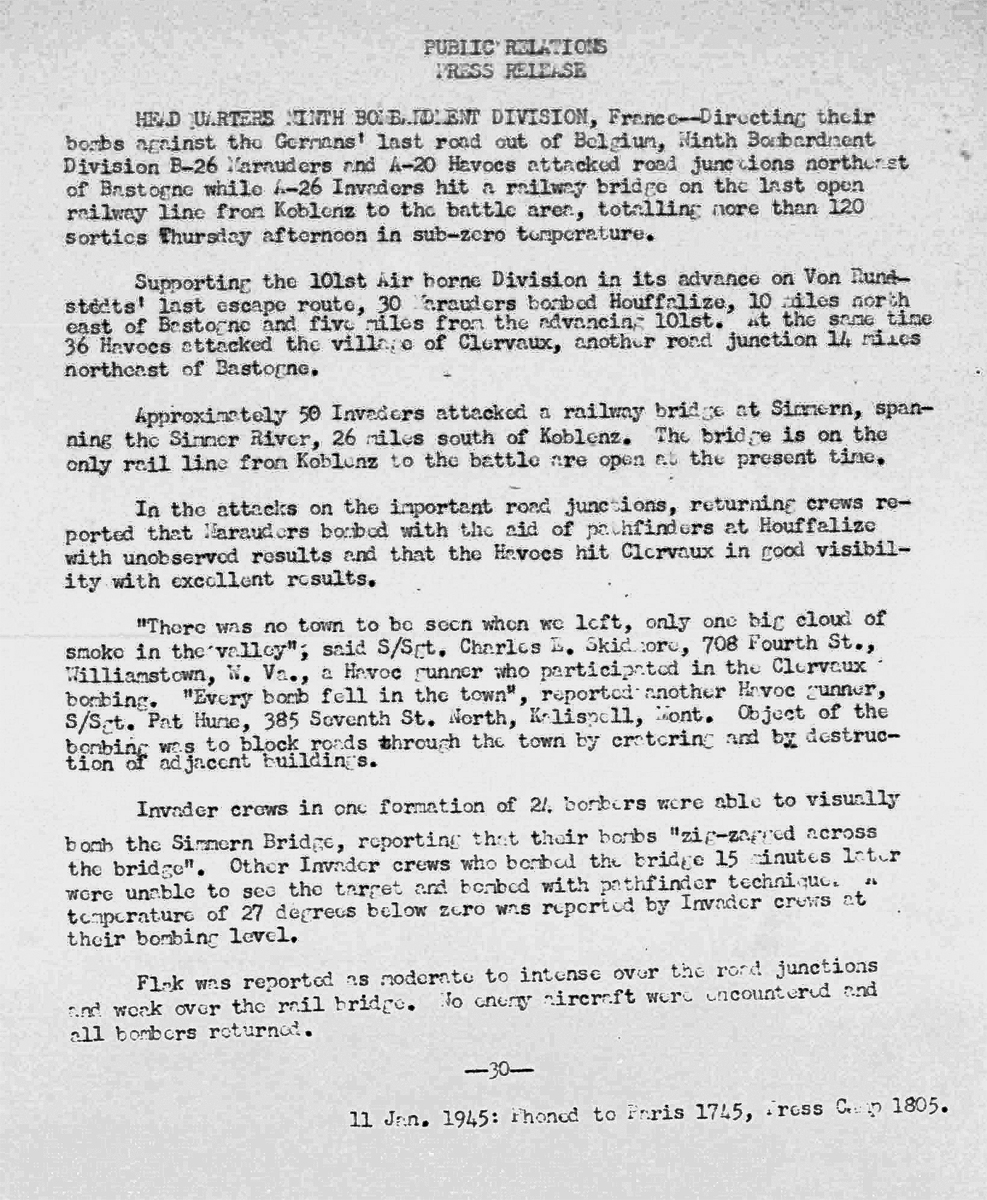
The press release above describes this mission carried out by the 344th BG and other groups. This mission was part of the action known as the Battle of the Bulge (Ardennes).
___________________________________
According to 344th Silver Streaks– “January 16 we proceeded on another Pathfinder mission with 33 planes to strike the rail bridge at Bullay. The run on the target was not good and the bombs dropped on the Pathfinder ship did not strike the aiming point.”
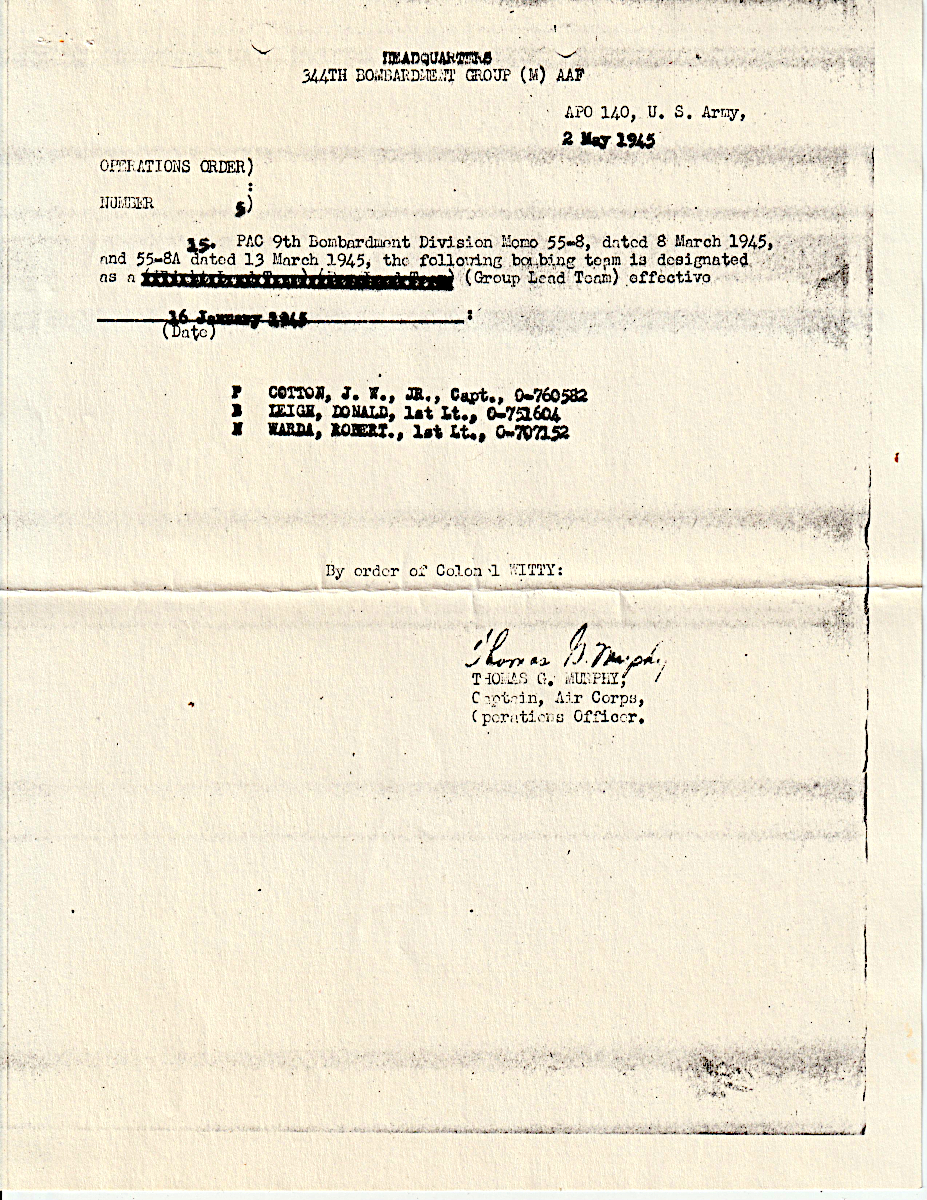
Cotton, Leigh and Warda are cited for leading the formation of the 344th Bomb Group on the Jan 16, mission.
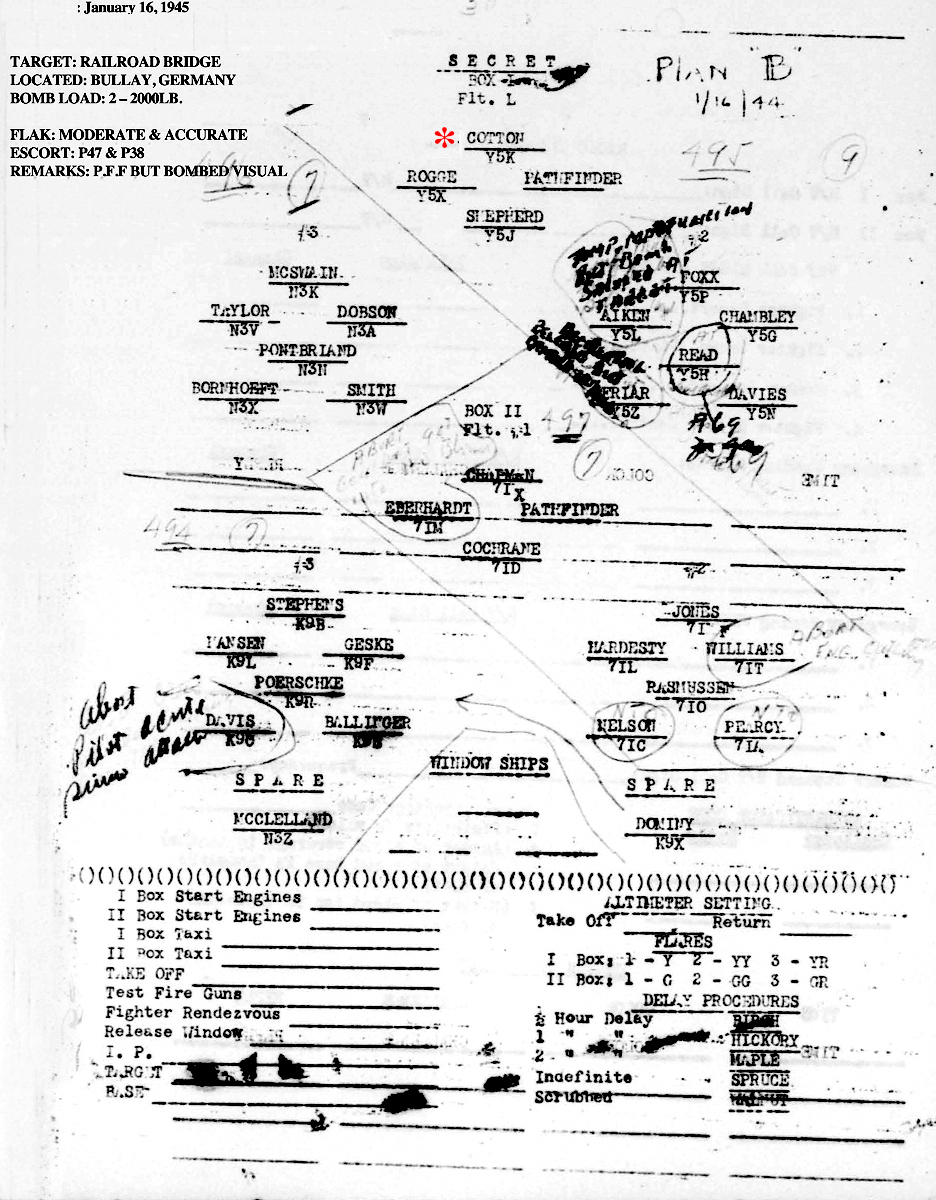
Don Leigh flew in, 42-95911 Mary Mae Y5-K which was piloted by Cotton in position 1-1-1. They once again were honored by leading the formation.
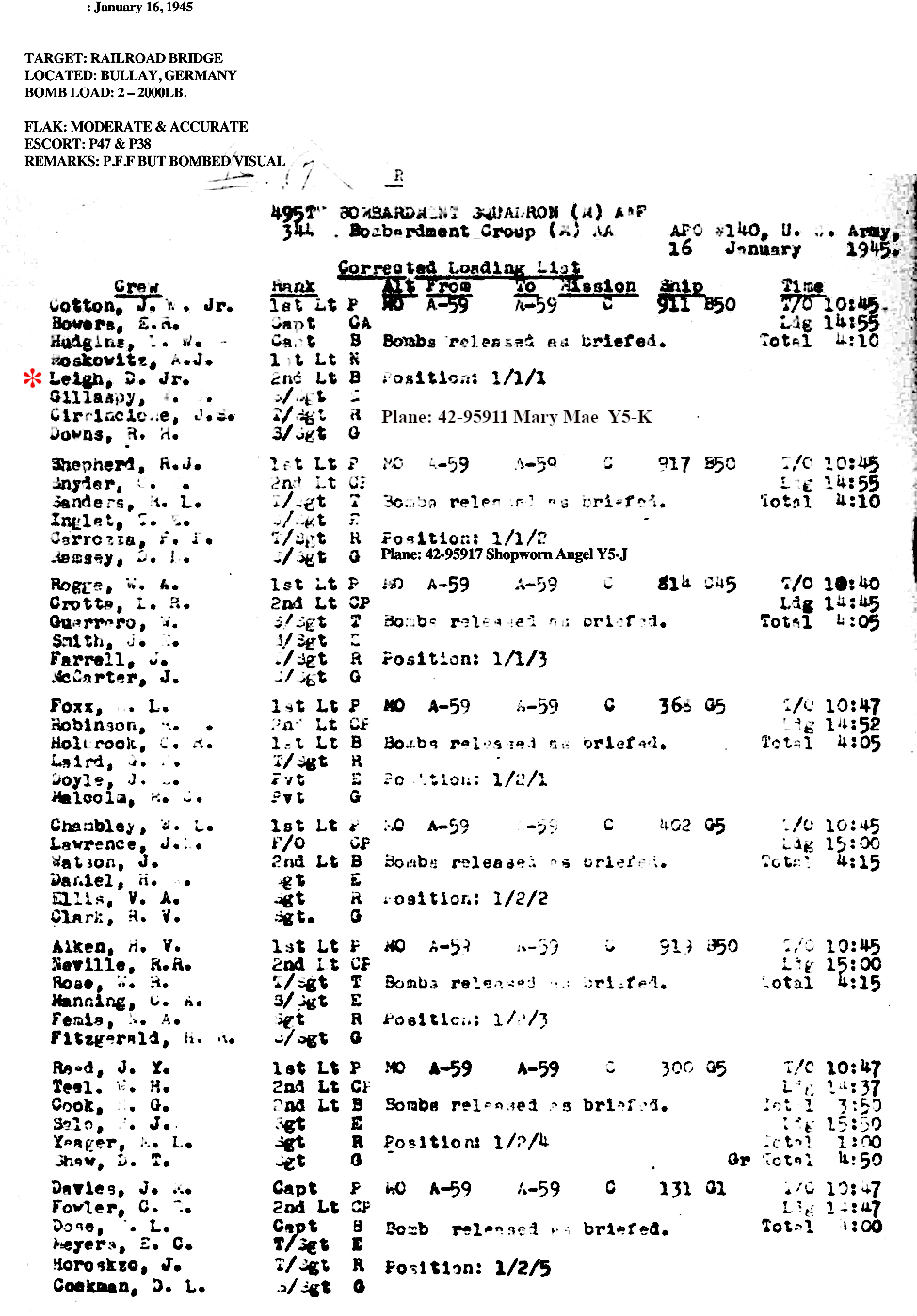
The crew consisted of: 1st Lt. Cotton, pilot; Captain Bowers, co-pilot; 2nd Lt. Leigh bombardier; Captain Hudgins, Bombardier; T/Sgt. Cirrincione, radio/gun; S/Sgt. Gillaspy, eng/gunner; S/Sgt. Downs, gunner. They flew in, 42-95911 Mary Mae Y5-K, taking off at 10:45 am and landing at 2:55 pm.
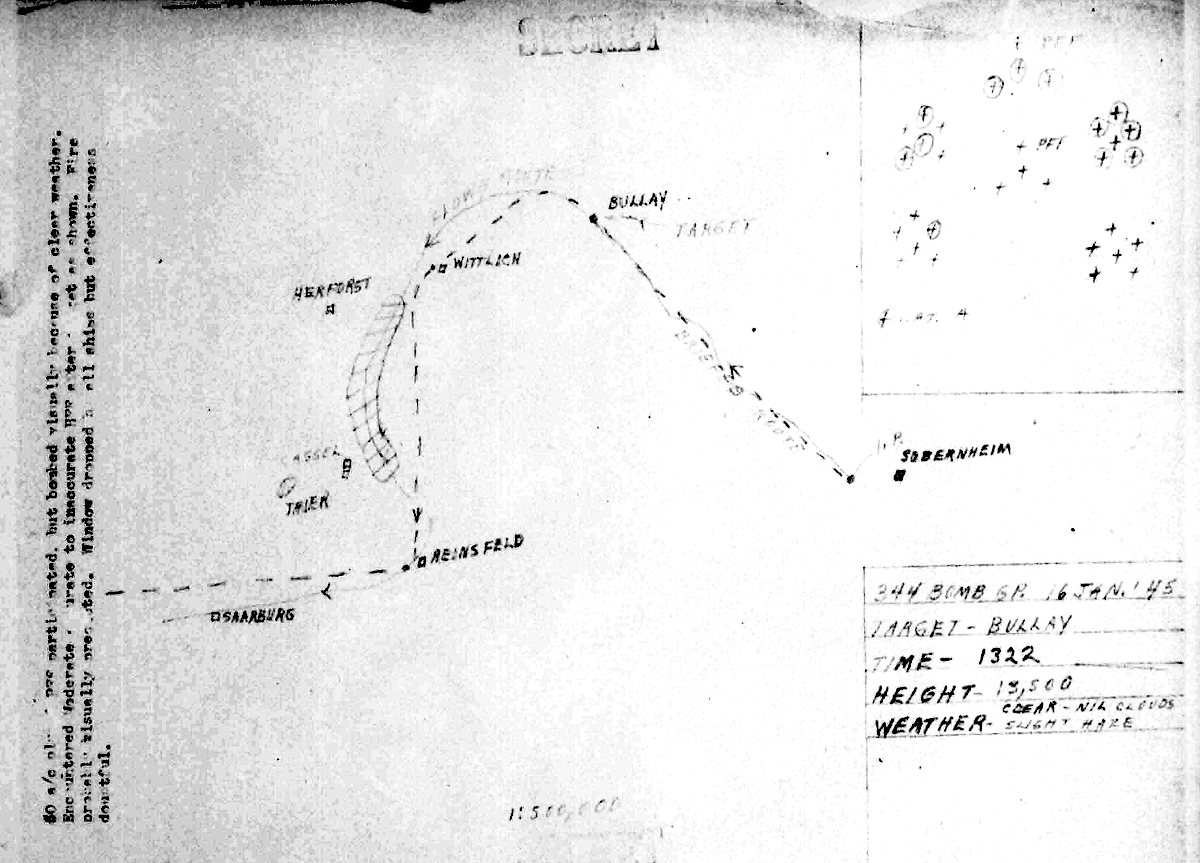
? A/C planes and PFF participated, but bombed visually because of clear weather. Encountered moderate and accurate to inaccurate HFF after target as shown. Fire probably visually ?. Window dropped by all ships but effectiveness doubtful. 12 planes received Cat. A damage. The target of Bullay was attacked at 1:22 pm from 13,500ft. The weather was clear with slight haze.
February 14, 1945 According to 344th Silver Streaks– In the afternoon of the 14th the Railroad bridge at Engers was attacked. Seventeen (17) Aircraft dropped 34 tons of bombs with generally excellent results, though clouds and haze were rapidly obscuring the target from view. The attack being visually, by flights, on converging axis of attacks and the weather closing in did not allow all of the Aircraft to drop on the primary target. However, on the way out to Base, two (2) Aircraft bombed at Bullay on briefed secondary and four (4) on the Railroad bridge at Ellers, another briefed secondary target, while one plane bombed the town of Burenbach as a casual target. The attack on the Euskirchen bridge was met by severe and accurate enemy flak defenses, five of our aircraft being shot down, 21 Aircraft damaged Cat-“A”, seven Category “B” and 31 of our personnel listed missing and six wounded. It was the first time since our attack on a bridge North of Paris that so many of our craft were lost in action and so many damaged. The five (5) Aircraft were of the 495, 496, and 497th Bomb Squadrons.
Click to see an extensive report about the 344th and this Valentines Day (Feb 14, 1944) mission.
MACR# 12344 DATE – 14 Feb 1945
PILOT – Capt. Thomas Gough Brennan, Jr 0-793050 (bailed out, POW)
COPILOT – 2nd Lt. Frederick William LaFountaine, Jr 0-714713 (killed by civilians)
BOMBARDIER- 2nd Lt. Harry William Zuest 0-2068152 (killed by civilians)
RADIO/GUN – Sgt. Roy Fred Pace 38519975 (bailed out, POW)
ENG/GUN – Sgt. Edward Joseph Monahan 12144326 (killed in crash)
TAIL/GUN – Sgt. Willard Alexander Delavan 11108168 (bailed out, POW)
MACR# 12352 DATE – 14 Feb 1945
PILOT – 1st Lt. William Riley Jones 0-760860 (killed)
COPILOT – 1st Lt. Richard Carroll Light 0-822950 (killed)
BOMBARDIER- 1st Lt. Melvin Ray O’Brien 0-712211 (killed)
RADIO/GUN – S/Sgt. Norman Dorwood Polk 33676696 (bailed out, POW)
ENG/GUN – T/Sgt. Uel Milton Myers 36657182 (killed)
TAIL/GUN – S/Sgt. Peter Newton Dudley 19113146 (killed)
GEE OPERATOR – 1st Lt. John Edward Knight – 0-735319 (killed)
MACR# 12385 DATE – 14 Feb 1945
PILOT – 1st Lt. Robert Clyde Meppen 0-410683 (bailed out, POW)
COPILOT – 2nd Lt. Glenn Richard Farthing 0-715172 (bailed out, POW)
BOMBARDIER- 2nd Lt. Gustave Philip Larson, Jr 0-685494 (bailed out, POW)
RADIO/GUN – T/Sgt. Samuel Louis Myers 31133606 (bailed out but killed by small arms
fire on descent)
ENG/GUN – Sgt. James Chiari, Jr 32768604 (seriously injured by flak, killed in crash)
TAIL/GUN – Sgt. Elman Cheramie 38493255 (killed by flak)
MACR# 12386 DATE – 14 Feb 1945
Pilot- 1st Lt. Gordon Kenneth Holm 0-705691 (killed)
CoPilot- 2nd Lt. William Marshall Holman 0-713445 (bailed out, POW)
Bombardier/Nav.- 2nd Lt. Phillip George Mulholland 0-712206 (killed)
Radio/Gun- Sgt. William Arthur Spear 18168356 (bailed out, POW)
Eng/Gun- Sgt. Melvin Bernard Rasalais 38486560 (killed)
Tail/Gun- Sgt. Frank Alton McKenny 17144709 (killed)
MACR# 12387 DATE – 14 Feb 1945
Pilot- 1st Lt. John Paul Nelson 0-706233 (killed when his parachute failed to open)
CoPilot- 2nd Lt. Douglas Thore Bennett 0-1996043 (bailed out, POW)
Bomb/Nav.- 2nd Lt. Walter Phillip Santel 0-2061265 (bailed out, shot in knee by German soldier, POW)
Radio/Gun- S/Sgt. Donald Eugene Brecht 6578282 (killed, possibly chute failed)
Eng/Gun- Sgt. Warren Oscar Severson 17109784 (bailed out, POW)
Tail/Gun- Sgt. Arthur John Sullivan 31373538 (bailed out, POW)
From a published article by now 1st Lt. Don Leigh –
Donald Leigh
495th Squadron, 344th Bomb Group
From a previously published article.
Scratch One Bridge At Koblenz
The crew of Y5-V (Rum Buggy II, a B26) [according to records it was another Y5-V not Rum Buggy II], 495th Squadron. knew what was coming on that late winter Valentine’s Day morning in Belgium. Flak map overlays distributed at briefing showed that on the assigned bomb run. twelve miles along the Rhine River, the 344th Bomb Group would face intense antiaircraft fire. Intelligence reported one hundred twelve 88 millimeter guns along the route and thirty five more at the target. the 1,237 foot Crown Prince Wilhelm ‘railroad’ bridge at Engers, Germany. just outside the city of Koblenz.
Captain J.W. Cotton. Pilot, and 1st Lt. Don Leigh. Bombardier, leading the high flight, discussed the ‘prospects’ and decided that since flying the usual evasive action to confuse German gunners would be pointless in what was sure to be a solid barrage, to fly a straight-in bomb run taking maximum time for sighting. This tactic would provide greatest bombing accuracy and the quickest possible route through flak.
Fifty years later Leigh vividly remembers that the sky was bright blue at 10,500 feet and visibility at the IP. was excellent, but despite the customary roar of the Marauder’s IB26] 2,000 horsepower engines there was a strange sense of silence as he called for Cotton to roll out on course for the bomb run. The lull before the storm was sure to come. And it came.
Skilled enemy antiaircraft fire was a daily fact of combat crew life, of course, but no one on this crew had experienced the intensity and unremitting barrage thrown up by the German gunners on this five minute bomb run from IP. to target. Oily flak puffs, punctuated by bright strawberry-red flashes, melded into a nearly dark sky, and the constant g-r-rr-u-m-p of close explosions was accompanied by a continuing hail-on-the-metal-roof sound of smaller fragments hitting the fuselage. Later, after return to base, an amazed crew counted 272 holes of varying sizes in the tough old B-26!
Captain Cotton’s steadiness and concentration under unrelenting fire made it possible for Bombardier Leigh to conduct an unhurried and precise sighting operation. The target was hit dead center. Leigh remembers (to his embarrassment, today) announcing on the interphone, “Bombs away,” followed by the corny cliché, “Let’s get the hell out of here.” But never was a diving turn off a target more welcome.
Two ships in the flight of six went down on the bomb run.

The complete 344th group lost five Marauders and their crews and planes received nearly 100% battle damage. Rum Buggy crew members, in addition to Leigh and Cotton, who shared the memorable mission, were: E.E. Edwards, Co-Pilot; W.E. Gillaspy, Engineer; J. Cirrincione. Radio; and D. Ramsey, Gunner. All of them can remember a Valentine’s Day on which they got the job done, but also the Valentine’s Day on which love was absent. [Leigh was awarded the Distinguished Flying Cross for this mission.] It is awarded to those who have distinguished themselves by single acts of heroism or extraordinary achievement while participating in aerial flight.
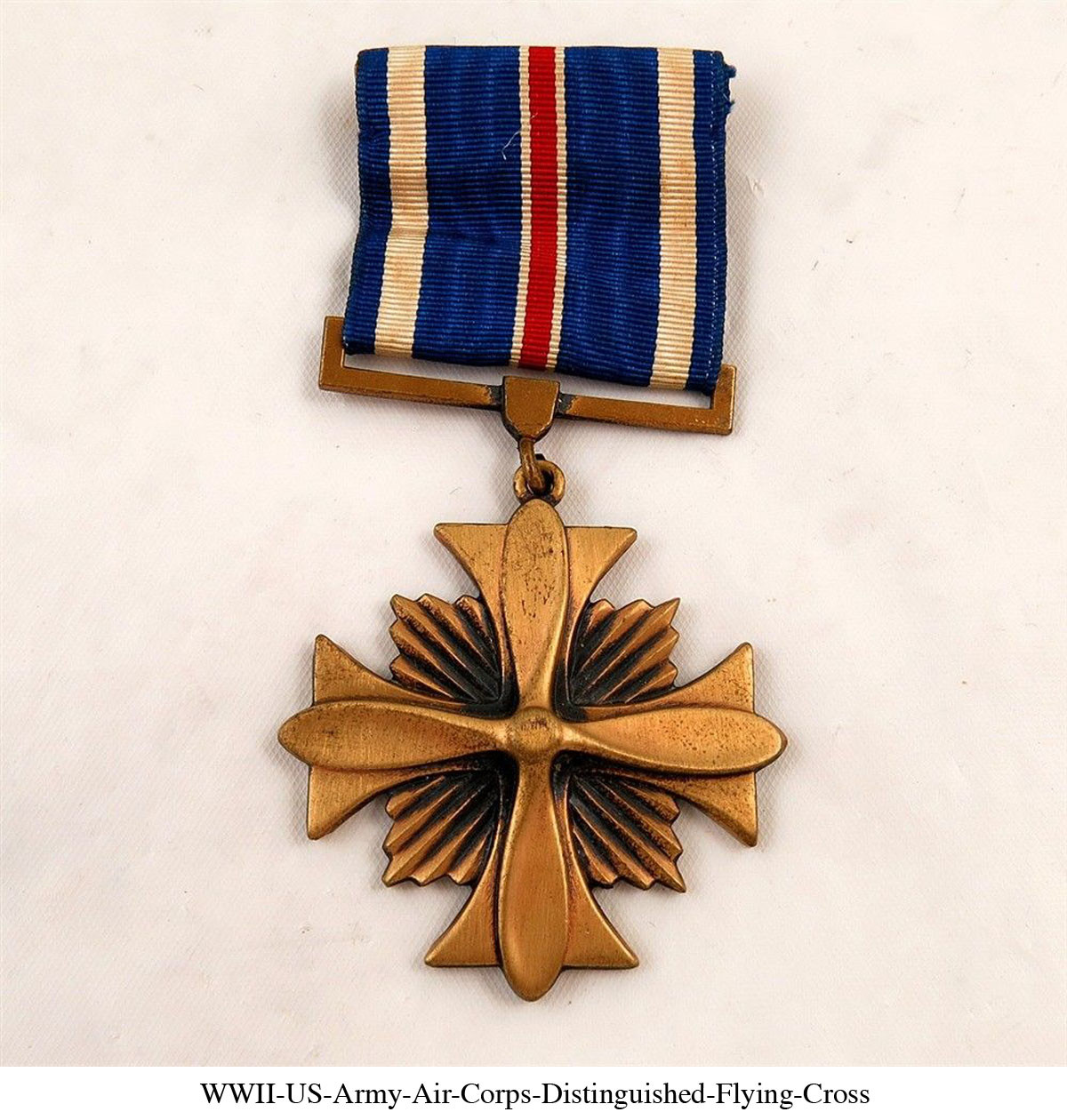
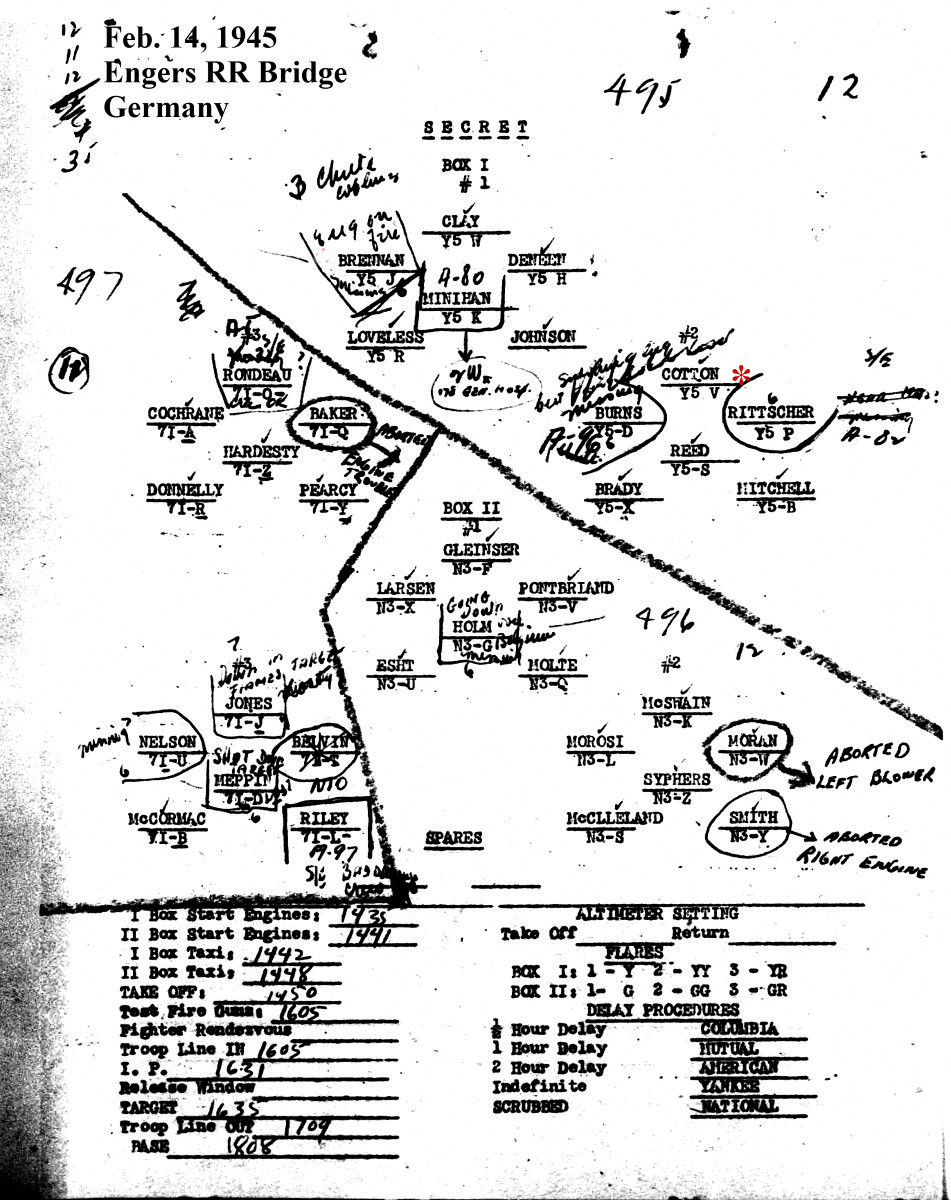
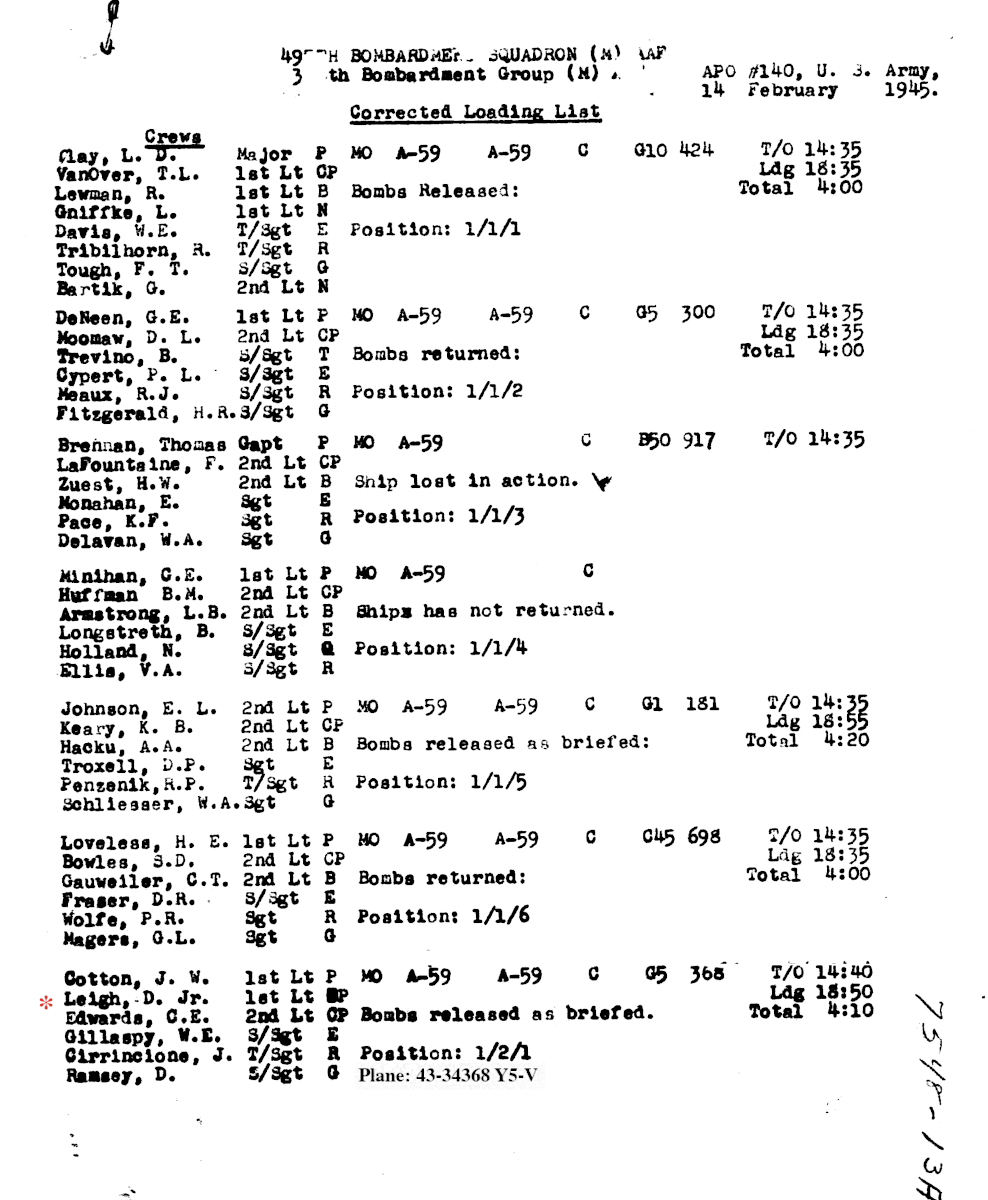
The crew consisted of: 1st Lt. Cotton, pilot; 2nd Lt. Edwards, co-pilot; 1st Lt. Leigh bombardier; T/Sgt. Cirrincione, radio/gun; Sgt. Gillaspy, eng/gunner; S/Sgt. Ramsey, gunner. They flew in, 43-34368 Y5-V, taking off at 2:40 pm and landing at 6:50 pm.

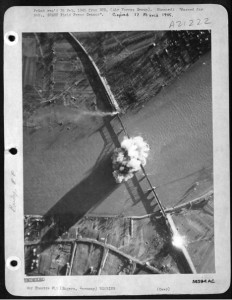
Engers Bridge being hit mid-span.
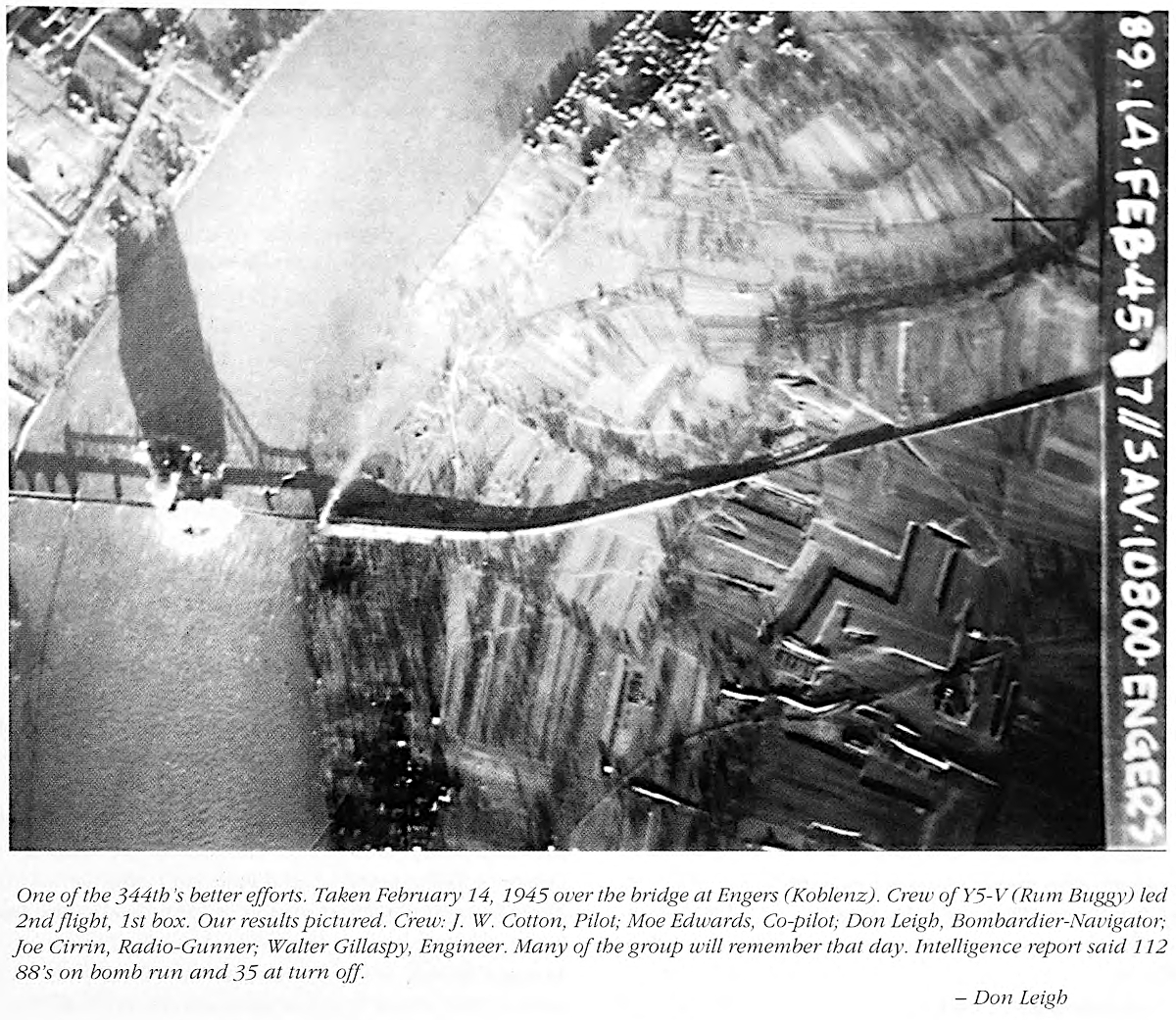
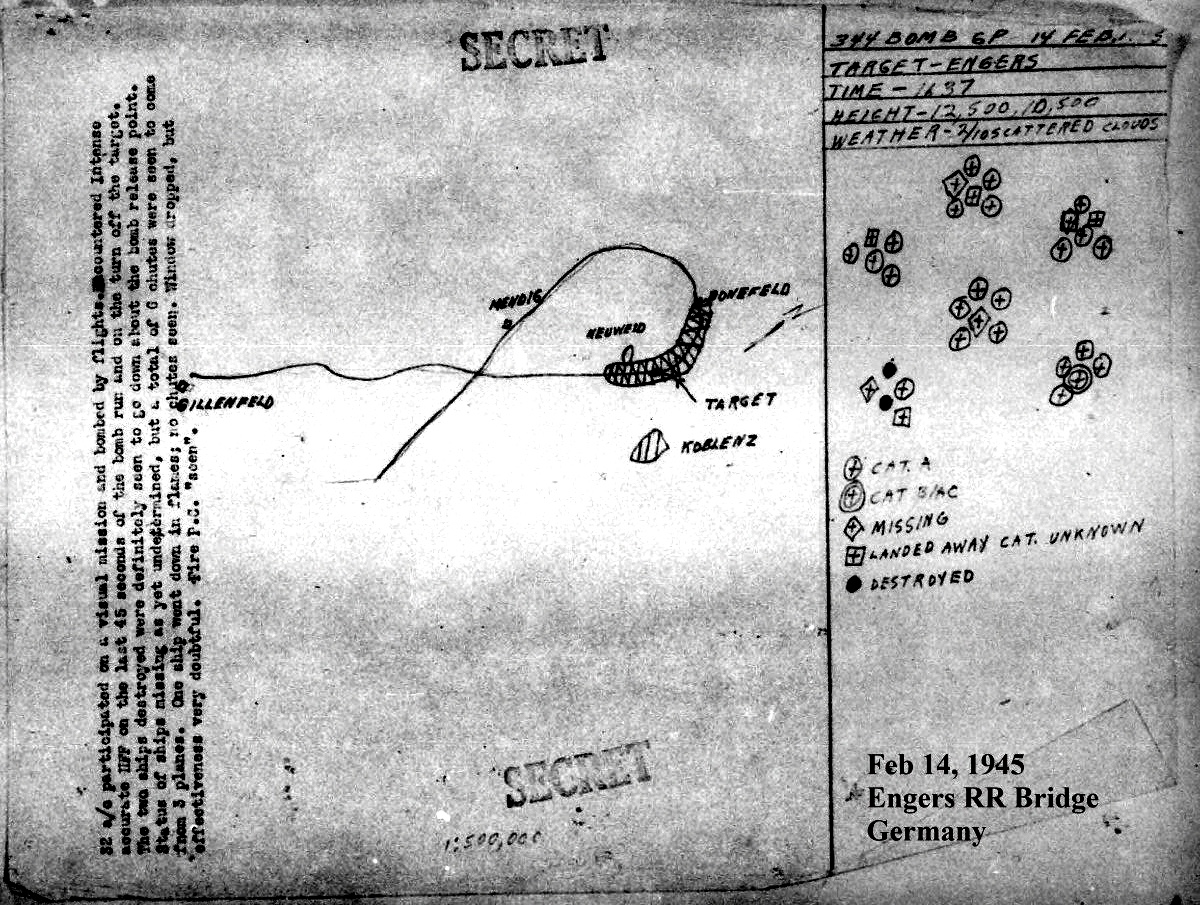
Hand drawn map for February 14, 1945 Target Engers R.R. Bridge- “32 aircraft participated on a visual mission and bombed by flights. Encountered intense, accurate HFF on the last 45 seconds of the bomb run and on the turn off the target. The two ships destroyed were definitely seen to go down about the bomb release point. Status of ships missing as yet undetermined, but a total of 6 chutes were seen to come from 3 planes. On ship went down in flames; no chutes were seen. Window dropped, but effectiveness very doubtful. Fire P.C. seen.” “
At least Catagory “A” damage to all planes.
Cat. “B” damage to: 2-2-4
Landed away from base: 1-1-4, 1-2-2, 2-3-5
Missing: 1-1-3, 2-1-4, 2-3-3
Destroyed: 2-3-1, 2-3-4
Time of attack- 4:37 pm
Altitude- 12,500 / 10,500
Weather- 2/10 scattered clouds
“On the morning mission of this same date, all of the lead element and the second flight turned back before enemy territory. these ships, however, turned back inside enemy territory and received weak, inaccurate flak in the vicinity of ? where we – – -.”
February 22, 1945 According to 344th Silver Streaks– “On February 22 the Group took part in a vast plan which had been the object of study by our lead Bombardiers, Navigators and Squadron Commanders for approximately one month previously. Top Secret information forwarded from Ninth Air Force disclosed the plan for the Eighth Air Force and the Royal Air Force to simultaneously bomb a network of communications centers behind the German Front lines in Germany, which would destroy rolling stock in the Marshaling Yards, tie up transportation of supplies and the shuttling of troops from the enemy’s reserve areas and Eastern front, and be a signal for our forces to start the penetration of the enemy defenses along the Rhine River.
Our part in this offensive was a maximum effort of Aircraft with eight targets as the objective. These targets were the Railroad bridges and Marshaling Yards at Hamm, East of Cologne, and a Railroad bridge and road bridge at Betzdorf. The railroad junction at Haiger, a Railway Station and Railroad bridge at Alsfeld, and the Railway station at Lauterbach. One (1) flight proceeded to each target and bombed at an average altitude of 8,000 feet. After bombing, they were to lose considerable altitude on the turn off the target and return to the same objective, strafing whatever installations remained in the target area. The plan so far as the 344th Group was concerned proceeded without a hitch and each flight caused severe damage to each of the targets attacked. One flight was unable to check point the Lauterbach target and proceeded to bomb the railway station at Alsfeld, as a secondary target. The route planned by higher Headquarters passed between enemy flak defenses and the formation avoided attack.
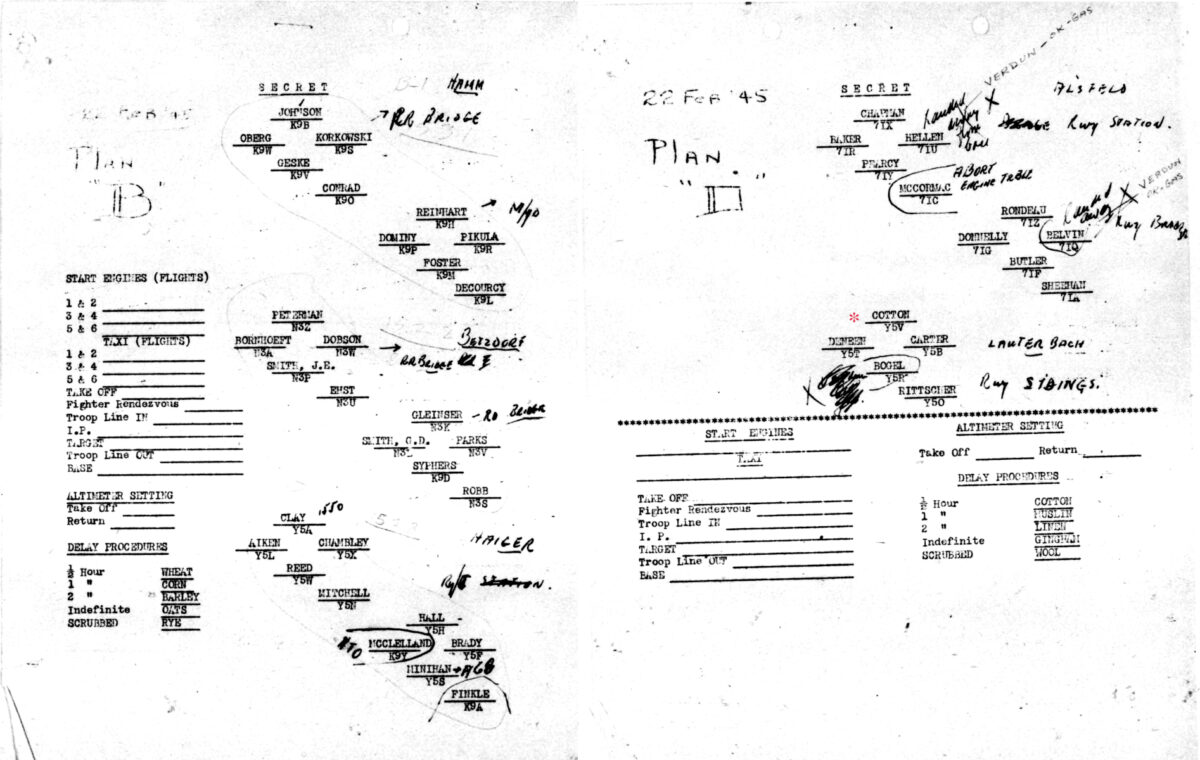
Don Leigh flew in, 43-34368 Y5-V which was piloted by Cotton in position 5-1-1.

The crew consisted of: 1st Lt. Cotton, pilot; 2nd Lt. Edwards, co-pilot; 1st Lt. Leigh, bombardier; 1st Lt. Warda, navigator; T/Sgt. Cirrincione, radio/gun; S/Sgt. Gillaspy, eng/gunner; S/Sgt. Tough, gunner. They flew in, 43-34368 Y5-V, taking off at 11:55 am and landing at 4:25 pm.
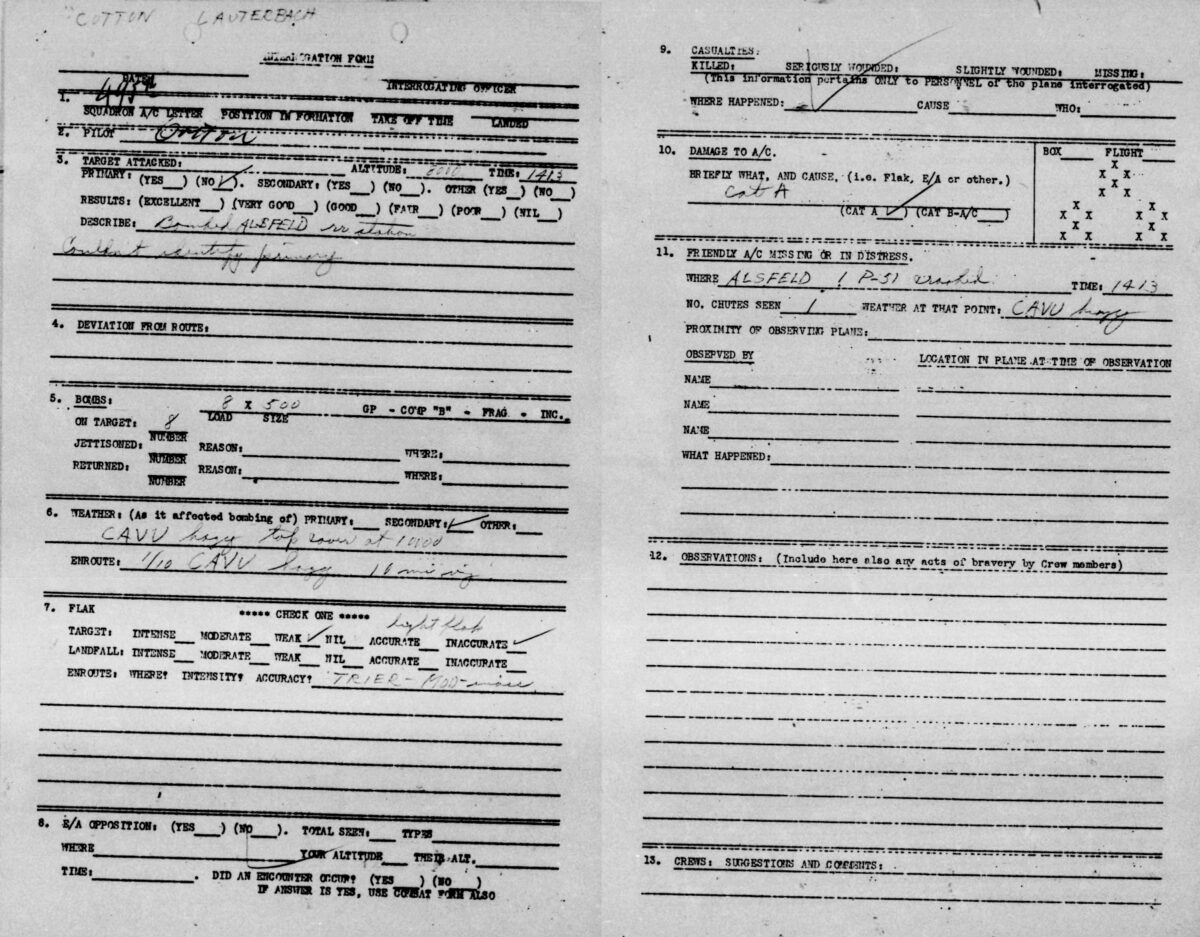
According to the mission debrief form complete by Pilot, Cotton, 2nd Lt. Leigh flew in, Y5-V, in formation position 5-1-1. After failing to identify the primary target he went on to the secondary target which was the Alsfeld Railroad Station. It was attacked from 8,000 feet at 2:13 pm using a load of 8 x 500lb bombs. Visibility was hazy CAVU (Ceiling And Visibility Unlimited) at the secondary target with top cover at 10,000 ft. 1/10 CAVU and hazy en-route with 10 mile visibility. They experienced weak and inaccurate flak at the target and moderate and inaccurate flak near Trier. Their aircraft received Cat. “A” damage. Cotton reported a friendly P-51 crash near Alsfeld with 1 chute seen.

Hand drawn map for February 22, 1945- “44 aircraft participated and bombed targets indicated then strafed the targets. Most of the flak damage resulted from HFF experienced. LFF fire weak and inaccurate on strafing run. One box receiving the most flak damage was engaged by Trier defense as shown. Fire P.C. “seen.” Several planes landed away from base low on gas.
Target #1 Ham, Target #2 Betzdorf, Target #3 Haiger, Target #4 Alsfeld,
Time- 1:53 pm / 2:52 pm
Height- Bombed 9000 / 8000 Strafed 1000ft and under
Weather- CAVU
Cat “A” Damage to 10 aircraft
April 16, 1945 According to 344th Silver Streaks– “The Communications Center at Zerbst was bombed April 16 with excellent results. Flak was encountered and 5 Aircraft were damaged Category “A.”
“…the target was Wittenburg marshaling yard. This target was only 35 miles from Berlin and we had to turn back and did not drop our bombs. The 88 flak was so bad the sky was black. We were told later that this target was a heavy bomber target. On our way home we dropped on our secondary target. This was so deep into Germany that we drew flak a half dozen times. Never knew when we were going to get shot at.”
By the end of the war, Leigh was awarded the Distinguished Flying Cross. Air Medal with seven Oak Leaf Clusters, and a Purple Heart for wounds suffered over Wittenburg, Germany on April 16, 1944.
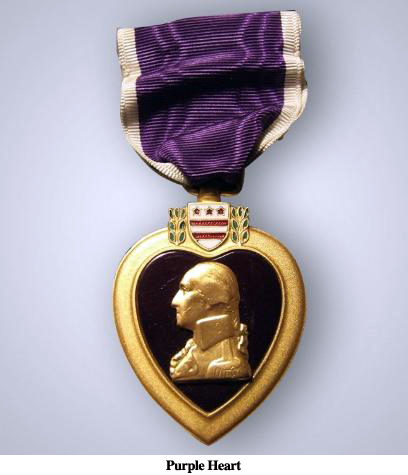
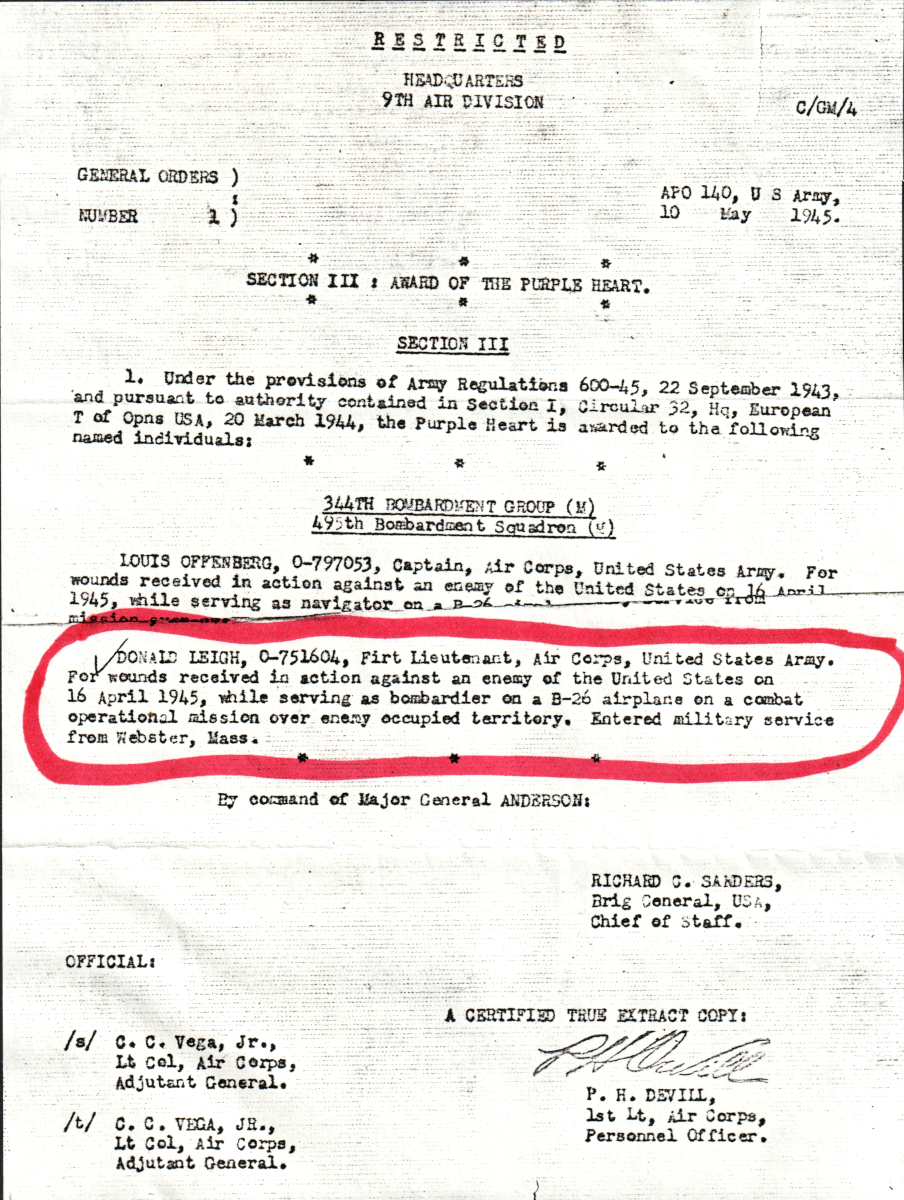

Don Leigh flew in, 43-34424 Y5-W Wild Willie which was piloted by Cotton in position 1-1-1. There was no load list (crew list) found for this flight.

According to the mission debrief form complete by Pilot, Cotton, 1st Lt. Leigh flew in, Y5-K (This conflicts with the formation diagram. Notice Cotton crossed out W and inserted K), leading the formation position 1-1-1 with a load of 8 x 500lb bombs. According to the deputy lead, Mitchell in Y5-F position 1-1-3, Cotton did not drop bombs on the target but salvoed them near the IP on return as a result, the first and second box did not drop.. load of 8 x 500lb bombs. Visibility was hazy CAVU (Ceiling And Visibility Unlimited) at the secondary target with top cover at 10,000 ft. 1/10 CAVU and hazy en-route with 10 mile visibility. They experienced intense and accurate flak at the target. Their aircraft received Cat. “A” damage. Leigh and Offenberg were wounded. No details have been found. Other pilots reported thick haze and smoke at the target but CAVU skies.
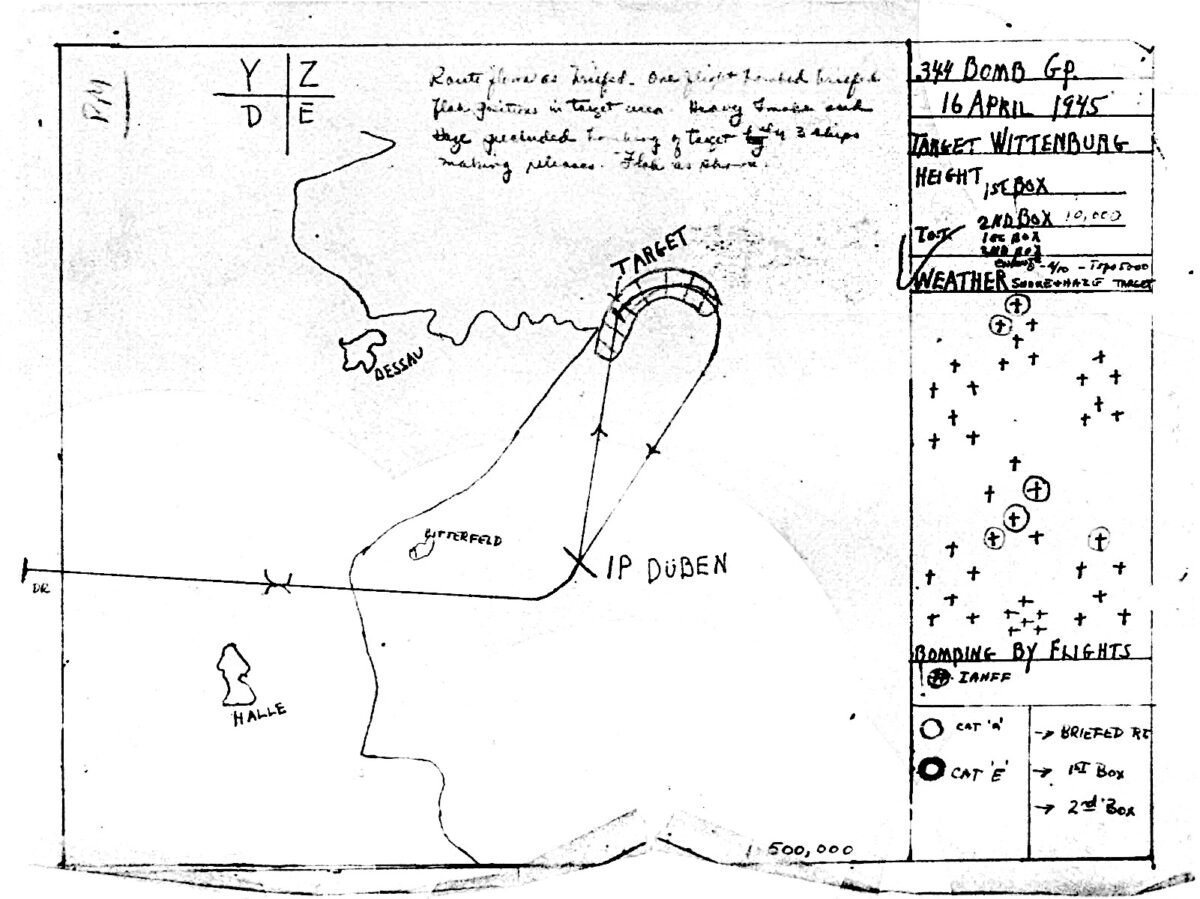
Hand drawn map for April 16, 1945- Route planes briefed. On flight bombed [as] briefed. Flak positions in target area. Heavy smoke and haze precluded bombing of target. Only three ships making releases. Flak as shown.
Target- Wittenburg
Height- Second Box 10,000 ft.
Weather- Smoke and haze
Cat “A” Damage to 6 aircraft including the lead plane (Cotton and Leigh)
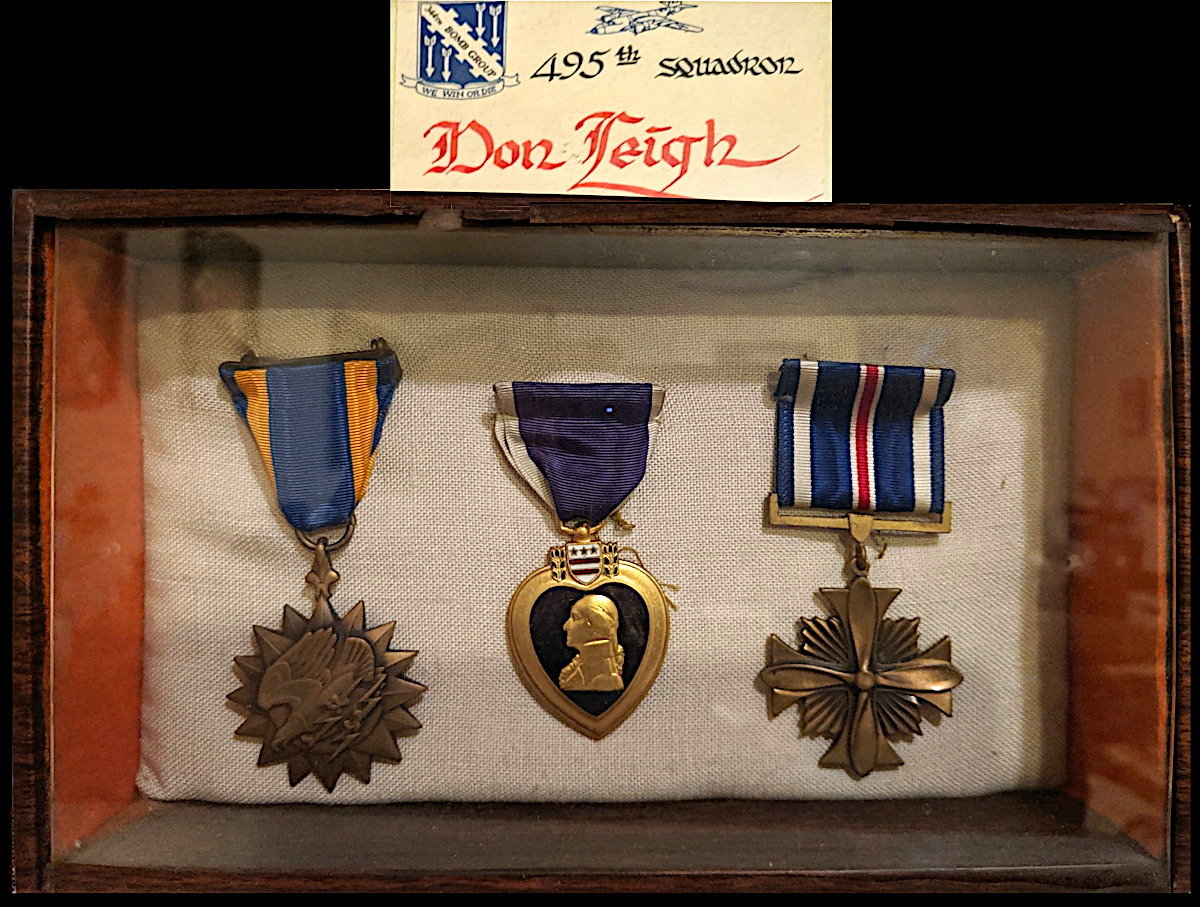
By the end of the war, Leigh had been awarded the Distinguished Flying Cross for the February 14th mission, a Purple Heart for wounds suffered over Wittenburg, Germany on April 16, 1944, and the Air Medal with seven Oak Leaf Clusters (signifying, that he had flown 40 missions. The Air Medal and OCL were awarded after each five missions.
Documents:
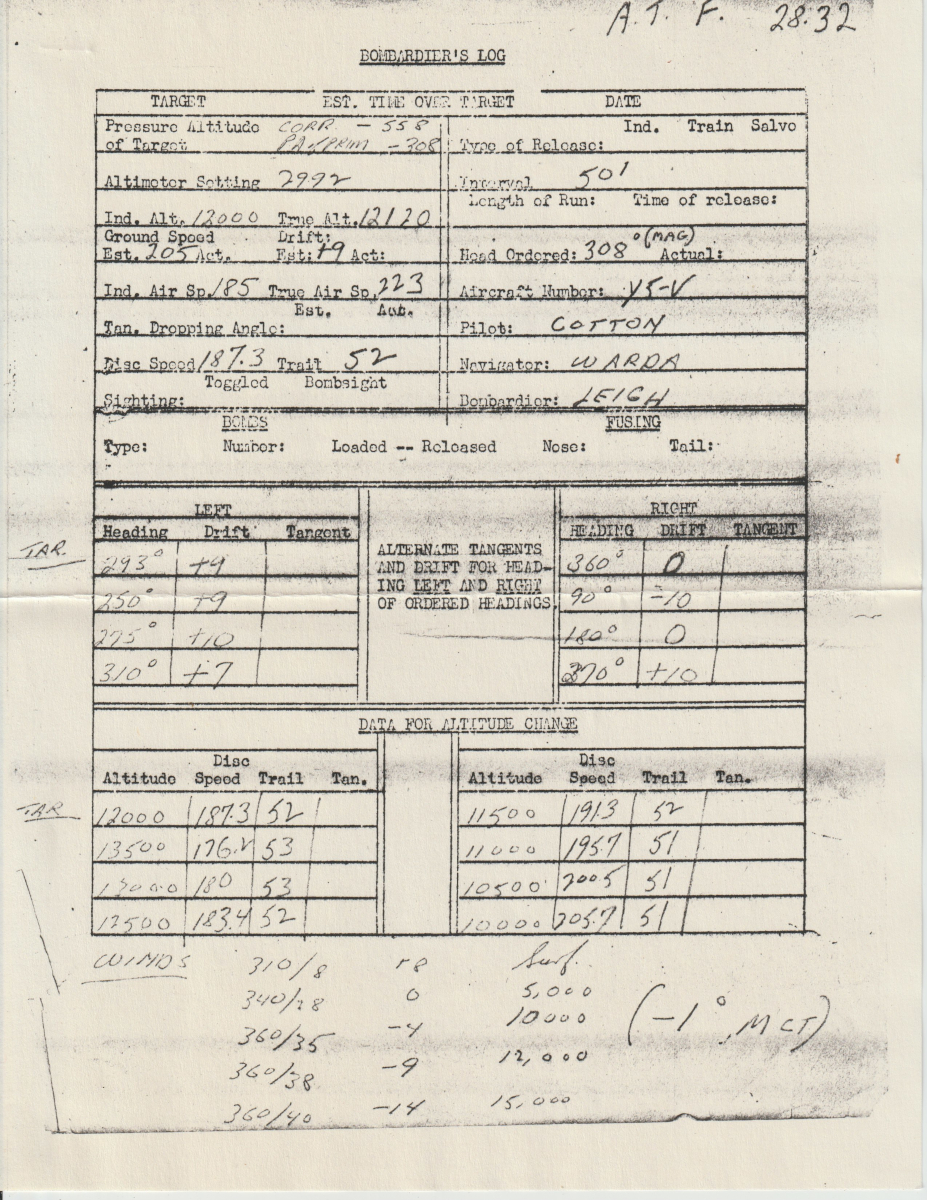
Some of the technical data a bombardier (especially a lead) must record!
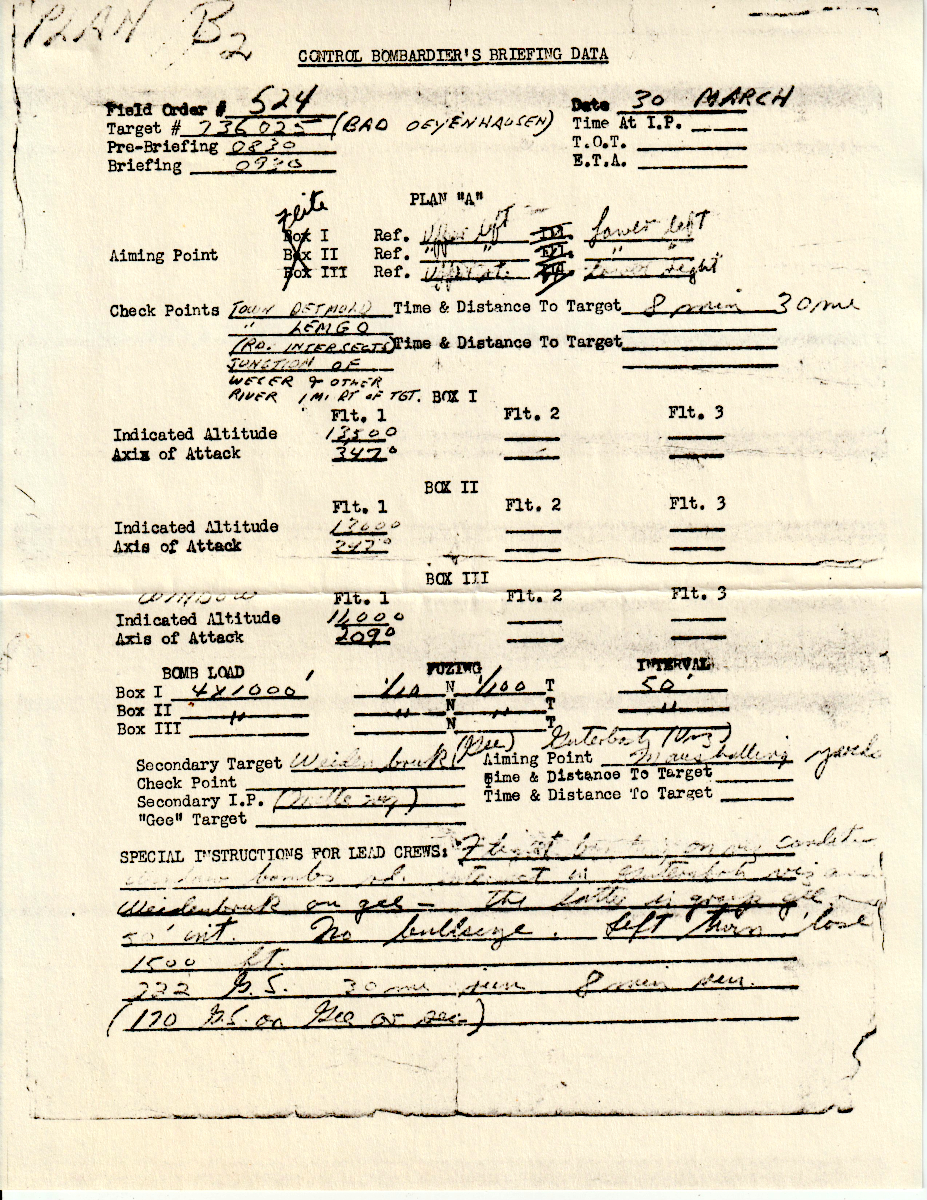
Bombardier’s briefing data for March 30, 1945 mission. No mention of the use of the secret “GEE” system.

Record of Leigh’s training flights.
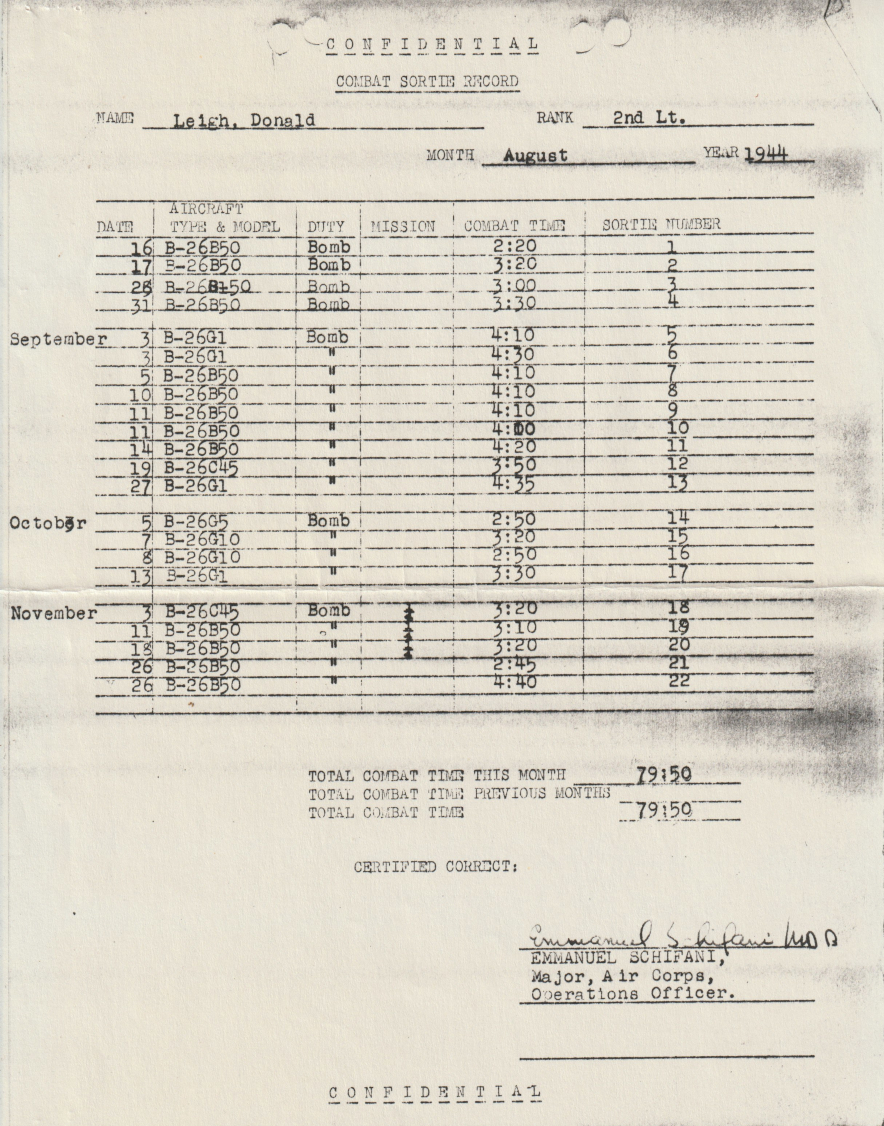
Combat Sortie Record August – November 1944
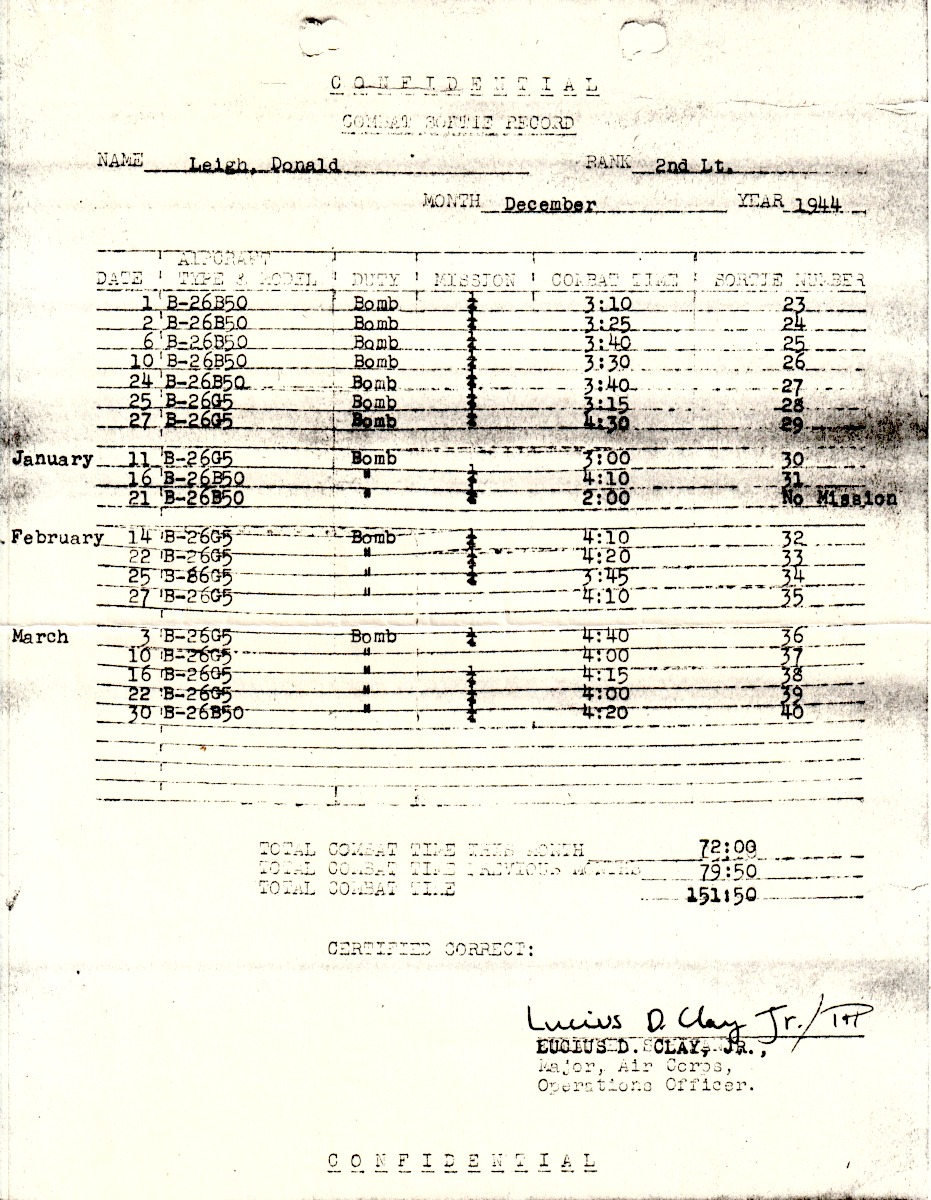
Combat Sortie Record December 1944 – March 1945
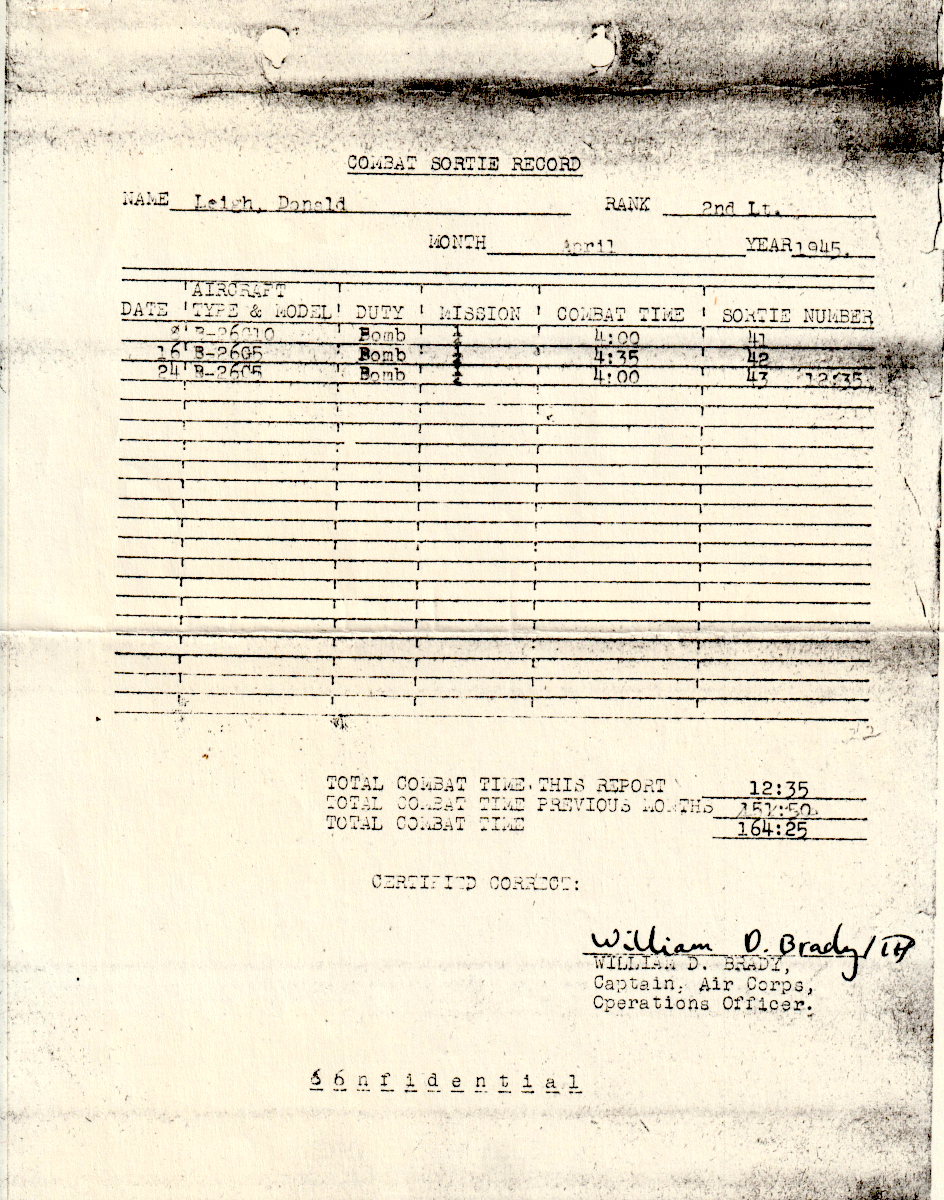
Combat Sortie Record April 1945. Note Don Leigh took part in the second to the last mission of the war.
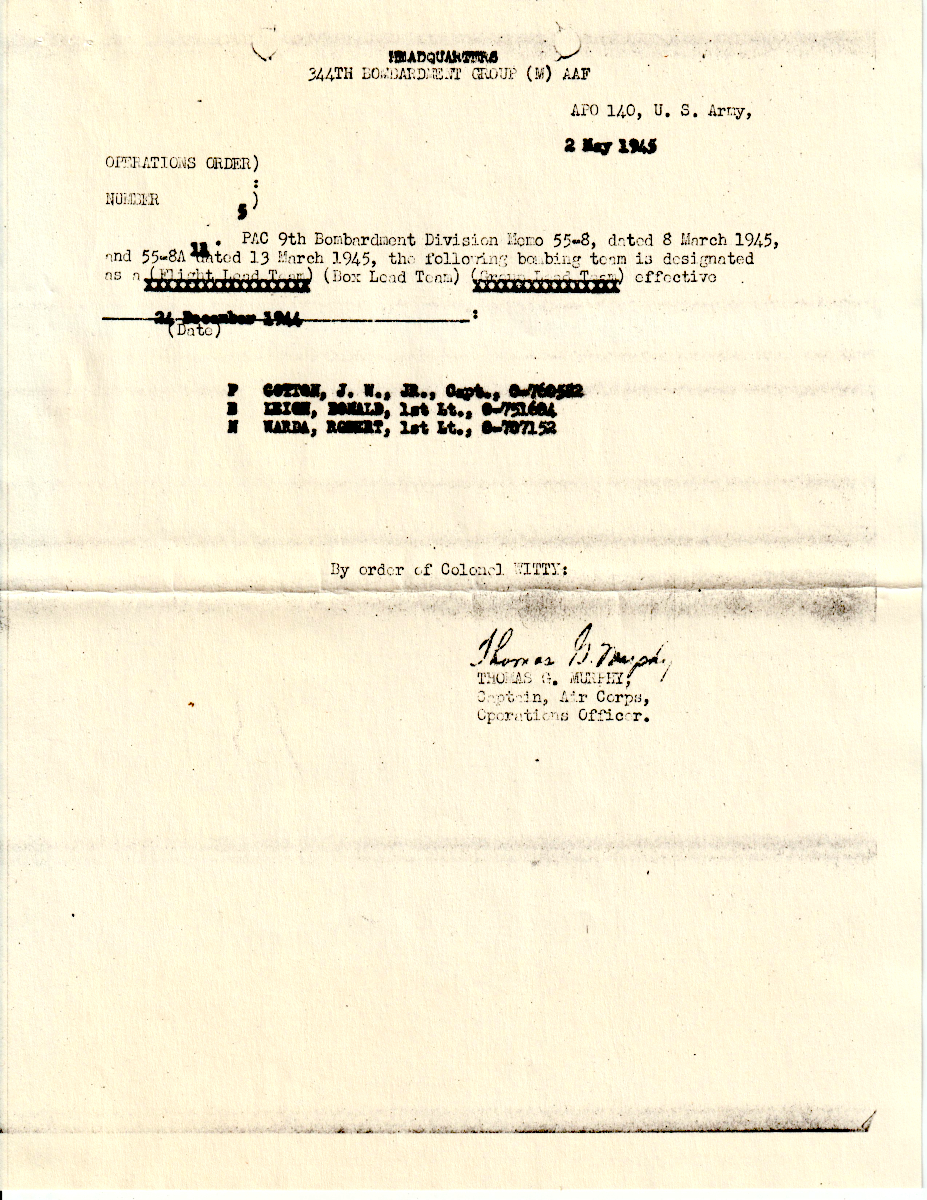
Cotton, Leigh, and Warda are designated as box leaders effective Dec. 24, 1944. This and the document below indicate the Leigh was held in great esteem and trusted to lead a box or a flight. This is important because the planes behind them would drop their bombs when they saw Leigh drop his.
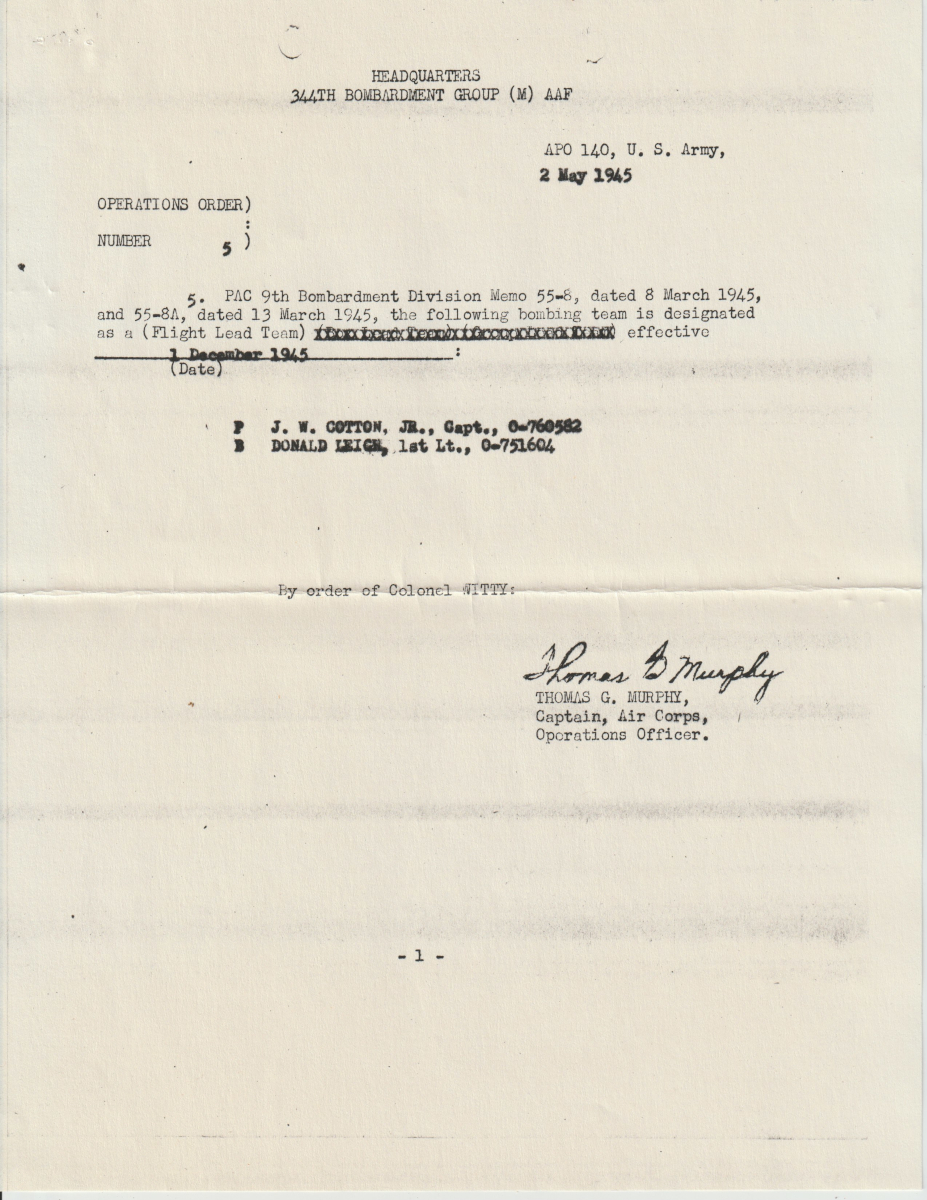
Cotton and Leigh, are designated as flight leaders effective Dec. 1, 1945

When the war ended, this document certified that Lt. Don Leigh had flown 43 actual missions. Of those, 22 were in a lead position which entitled him to 5 1/2 extra mission credits for a total of 48 1/2. This information was used as information for future advancement, military awards, and credits toward discharge. By the end of the war a complete tour of duty required 65 missions. In this case the war ended before that goal was reached.
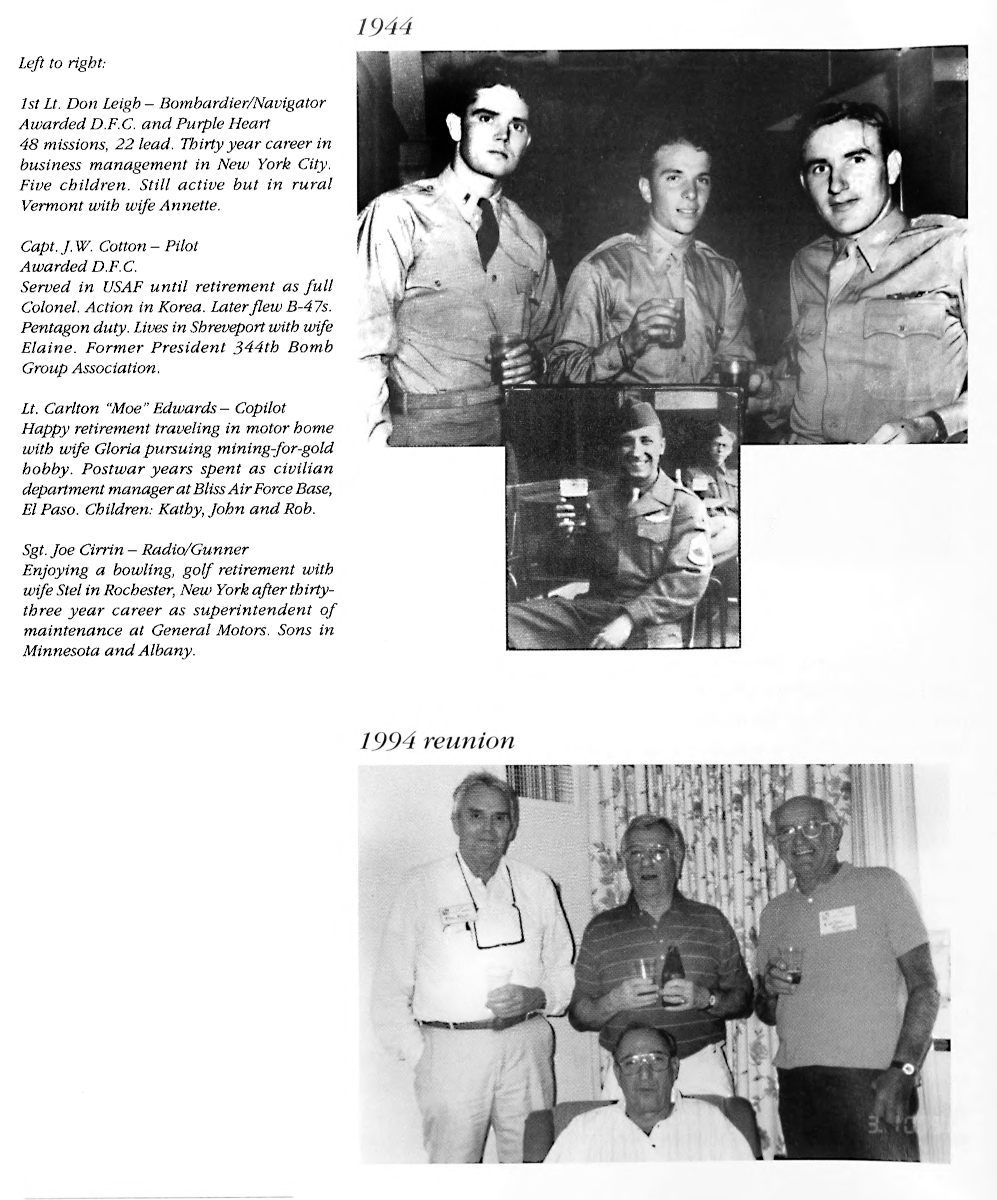
Lt. Leigh was able to keep in touch with members of his crew. Here is a great collage from wartime and at the reunion of 1994. The crew of Y5-V, “Rum Buggy II”—Then and Now
Left to right:
1st Lt. Don Leigh – Bombardier/Navigator Awarded D.F.C. and Purple Heart
48 missions, 22 lead. Thirty year career in business management in New York City. Five children. Still active but in rural Vermont with wife Annette.
Capt. J. W. Cotton – Pilot
Awarded D.F.C.
Served in USAF until retirement as fu ll Colonel. Action in Korea. Later flew B-47s. Pentagon duty. Lives in Shreveport with wife Elaine. Former President 344th Bomb
Group Association.
Lt. Carlton “Moe”Edwards- Copilot Happy retirement traveling in motor home with wife Gloria pursuing mining-for-gold hobby. Postwar years spent as civilian department manager at BlissAirForceBase, El Paso. Children: Kathy, John and Rob.
Sgt.Joe Cirrin- Radio/Gunner
Enjoying a bowling, golf retirement, with wife Stel in Rochester, New York after thirty- three year career as superintendent of maintenance at General Motors. Sons in Minnesota and Albany.
Special thanks to Don Leigh’s son, Brad Leigh. He was able to provide the amazing personal pictures and documents shown here.
Among the photos Don Leigh keep were the ones below of his friends. The pictures were not labeled, so we don’t know their names. If you recognize any of them, please contact Carl Carrozza Damonbok@hotmail.com.
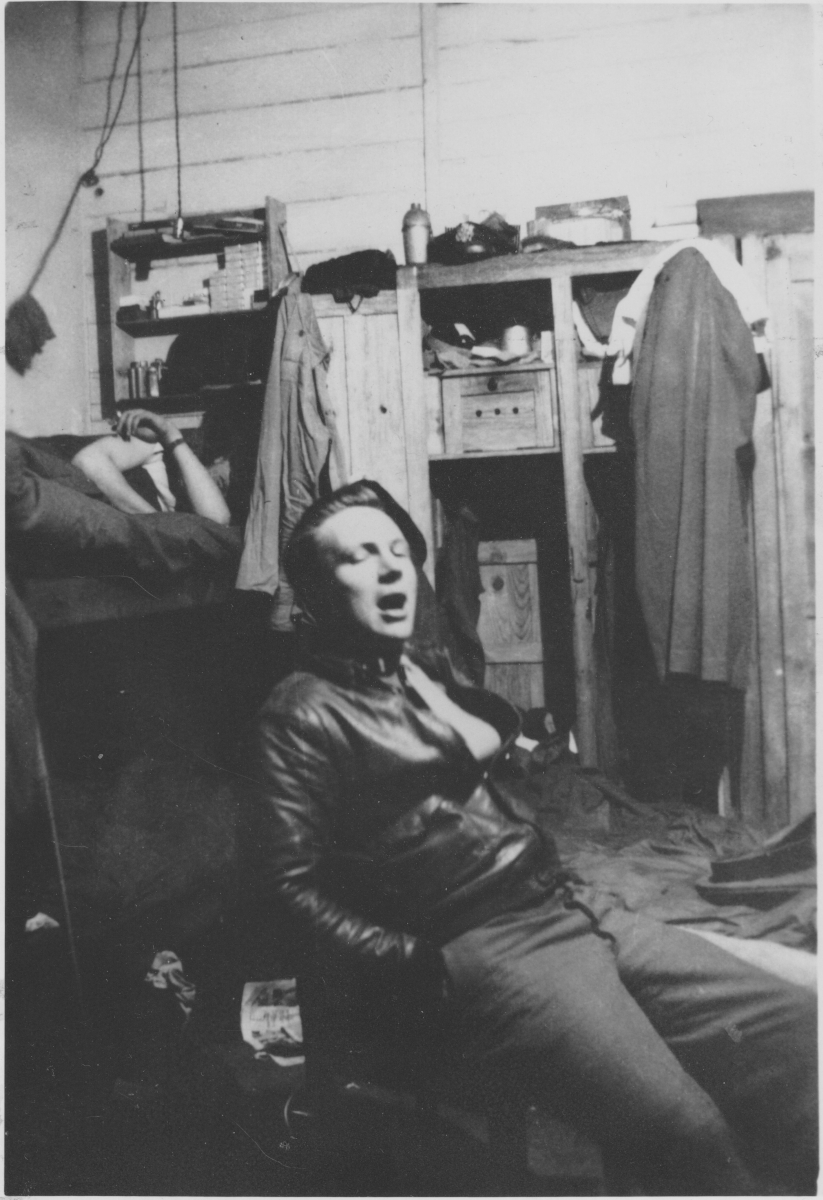
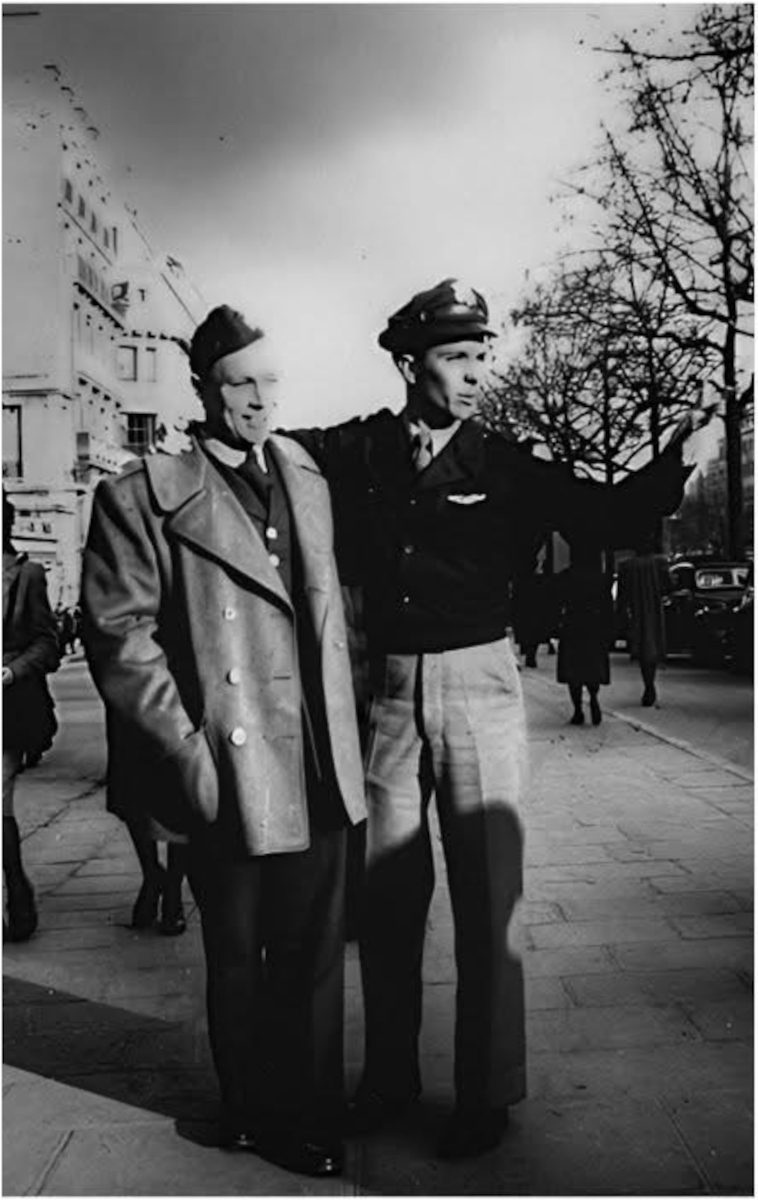

Finally, and excerpt from 344th Silver Streaks written by Lt. Donald Leigh himself;
Don Leigh
… the constant g-r-r-r-n-m-p of close explosions was accompanied by a continuing
hail-on-the-metal-roof sound of smaller fragments hitting the fuselage.
Valentine’s Day 1945, No love at Koblenz The crew of Y5-V (Rum Buggy II), 495th Squadron, knew what was coming on that late winter morning in Belgium. Flak map overlays distributed at briefing showed that on the assigned bomb run, twelve miles along the Rhine River, the 344th Bomb Group would face intense antiaircraft fire. Intelligence reported one hundred twelve 88 millimeter guns along the route and thirty five more at the target, the 1,237 foot Crown Price Wilhelm bridge at Engers, Germany, just outside the city of Koblenz. Captain J.W. Cotton, Pilot, and 1st Ft. Don Leigh, Bombardier, leading the high flight, discussed the ‘prospects’ and decided that since flying the usual evasive action to confuse German gunners would Ire pointless in what was sure to be a solid barrage, to fly a straight-in bomb run taking maximum time Don Leigh, Bombardier, 495th Sqd., Belgium in 1945. for sighting. This tactic would provide greatest bombing accuracy and the quickest possible route through flak.
Fifty years later Leigh vividly remembers that the sky was bright blue at 10,500 feet and visibility at the I.P. was excellent, but despite the customary roar of the Marauder’s 2,000 horsepower engines, there was a strange sense of silence as he called for Cotton to roll out on course for the bomb run. The lull before the storm sure to come. And it came. Skilled enemy antiaircraft fire was a daily fact of combat crew life, of course, but no one on this crew had experienced the intensity and unremitting barrage thrown up by the German gunners on this five minute bomb run from I.P. to target. Oily flak puffs, punctuated by bright strawberry-red flashes, melded into a nearly dark sky, and the constant g-r-r-r-u-mp of close explosions was accompanied by a continuing hail-on-the-metal-roof sound of smaller fragments hitting the fuselage. Later, after return to base, an amazed crew counted 272 holes of varying sizes in the tough old B-26! Captain Cotton’s steadiness and concentration under unrelenting fire made it possible for Bombardier Leigh to conduct an unhurried and precise sighting operation. The target was hit dead center. Leigh remembers (to his embarrassment, today) announcing on the interphone, “Bombs away,” followed by the corny cliche, “Let’s get the hell out of here.” But never was a diving turn off a target more welcome. Two ships in the flight of six went down on the bomb run. The complete 344th group lost five Marauders and their crews and planes received nearly 100% battle damage. Rum Buggy crew members, in addition to Leigh and Cotton, who shared the memorable mission were: E.E. Edwards, Co-Pilot; W.E. Gillaspy, Engineer; J. Cirrin, Radio; and D. Ramsey, Gunner. All of them can remember a Valentine’s Day on which they got the job done, but also the Valentine’s Day on which love was absent.”
